The Story of a Church on Pendle Hill, Edited by David J A Taylor, 2020
`And some there be which have no memorial… but these were merciful men, whose righteousness hath not been forgotten…. Their bodies are buried in peace; but their name liveth for evermore`. Ecclesiasticus, 44.
This history of the church has been brought about as most of the present congregation of Sabden Baptist Church have been attending for little more than 15 years. It was recently found that few knew any details about the church throughout its earlier years, despite its early foundation in 1797. The present document is an attempt to address this.
The greater part of the earlier section of the text is taken from `No Mean Witness` an unattributed publication by the Burnley Express, published in 1947 to celebrate the Ter-Jubilee of the church. This sets out the history of the church up to that date and is included with some additions and omissions. Great reliance is also placed on `The Birth of a Lancashire Village – Sabden` by Clifford Moorhouse and several sections are quoted from this. The second history of the Church is taken from The Church Book, which also lists the Church Members from its foundation. This is included in its entirety as it relates details not mentioned elsewhere.
Unfortunately there are few early original records held by the church as these were destroyed some years ago. Few minute books remain but these include the Annual General Meetings from January 1976 – August 1987, the Deacons Minutes February 2007–November 2015, Church and Deacons minutes August 1961 – October 1975 and Church Meetings 2002-15. Fortunately a minute book of the Building Committee dating to the time of the erection of the new buildings in 1910 together with a record of Sunday School teachers meetings in the 1970s have also survived. A later Burial Register had also been retained. Additional information has been obtained from newspapers, word of mouth and various other papers held by the church.
The Birth of a Church
The closing decade of the 18th century was a momentous one, not only for Europe but for England. France was wallowing in the blood bath of its famous Revolution. The Reign of Terror, culminating in regicide and massacre in January 1793 produced Bonaparte, an ambitious militarist in his early twenties who, sated by an easy conquest of central and southern Europe, plotted invasion against Britain. Prime Minister Pitt, advocate of peace, was plunged into bitter war schemes. The Navy was in an unprecedented state of mutiny. Nelson sailed in Vanguard. The social structure of Britain had experienced a violent shock. The industrial and agricultural revolutions were causing intense suffering in the lower strata of society. Sympathetic and intelligent people whose emotions got the better of them, were using exciting language. Hungry men were led to desperate courses. Justice was deliberately perverted in a panic to hold down the lower classes to stave off revolution. In 1795 the Seditious Meetings Act was passed, prohibiting assemblies of more than 50 persons. Religious freedom was once more in jeopardy.
Sabden, known as Heyhouses in the Rural Deanery of Whalley, contained no Dissenters until 1681 when George Hargreaves of Pendle, a clothier, was fined £20 (a very large sum in those days), for holding an unlicensed meeting-house and permitting Isaac Ashton of Clitheroe to pray and preach not using the Book of Common Prayer. This probably took place at Whymond Houses, just over the Nick of Pendle towards Pendleton.
The history of Sabden Baptist Church is practically concurrent with the industrial revolution which transformed the hamlet during the last years of the 18th century. Prior to 1793 Sabden was a tiny isolated hamlet boasting few farmsteads and fewer dwellings. The earliest description of the village is dated to the mid-19th century and is set out in `The Birth of a Lancashire Village` by Clifford Moorhouse. At this time the population would have been around 2000. It is portrayed as, `being situated almost at the end of a narrow, barren valley, approached by a long straight road starting from the railway station at the neighbouring village of Whalley some three and a half miles away. The distance from a railroad caused Sabden to be isolated to a great extent from the rest of the world. The road from Whalley led no further than the village and although the valley stretched forward for nearly another two miles and the hillsides were studded with little farmhouses, there seemed to be no means of communication between Sabden and the higher end of the valley, except by means of deeply rutted occupation roads and meadow footpaths. People arriving at Sabden for the first time said that it seemed like getting to the end of the world. And so indeed it did, shut in as the village was by lofty hills on each side with only the one decent means of approach by the road from Whalley`. This road, built in 1818, was a private road constructed to serve the print works, particularly with the delivery of coal and transfer of materials. Initially it was called `The New Road in order to distinguish it from the road along the south ridge of the valley which was often almost impassable in places. That part of the valley in which Sabden stood was so narrow that there were very few yards width of level ground and consequently, the houses were seen climbing irregularly up the hill on each side; all except those which flanked the one long street which extended for about a quarter of a mile lengthways down the valley. Where the Whalley or “New Road” ended in the village there were also roads at right angles out of the valley over Pendle Hill to Clitheroe and over Black Hill to Padiham and Simonstone but these were very steep and difficult for horses and carts and were little better than farm tracks or occupation roads`.
`Altogether Sabden was not a pretty or picturesque place and in the winter a dreary one indeed. In the summer, when the range of hills on the south side of the village was clad in the bright green foliage of larch, with which tree it was thickly planted, it presented a somewhat pleasanter aspect, but on turning one`s back to the south, the mind suddenly became depressed by the bleak, barren ridge opposite. In summertime, both girls and boys went barefooted and some of the latter were like that through the winter. The dress was simply fustian jacket and trousers and if anyone had a Sunday suit it was of velveteen or uncut fustian`.
In 1793 Messrs. James Bury and Sons of Accrington, in company with Thomas Hargreaves and Edward Burford, established the Sabden Calico Printworks, which afterwards became world-famous. The purity and ample supply of water in the valley being the reason for its location.
Extract from Minute Book of Macpalah Baptist Church, Accrington:
`The Rev. William Wade, being discouraged on account of a number of his friends going to reside in Sabden, he left Accrington in the beginning of November, 1795`.
This was a direct result of the new calico printing works and led to the formation of the church as described below:
Extract from “Preston Guardian”, July 10th, 1910:
`With the increase of population, Messrs. Bury, who were religious minded men, felt it their duty to try and make some provision for the spiritual and moral necessities of the village in which there was no place of worship. Being prominent members of the Baptist denomination, they decided to erect a chapel in connection with that body and on October 29th, 1796, nine persons met in a cottage in the valley to take into consideration the propriety of erecting a building, by subscription, to be used as a Dissenting meeting house and Sunday School. The names of these originators were:- James Bury, John Bury, James Sykes, John Entwistle, Richard Preston, William Kirk, John Noble, James Greenhalgh and Martin Greenhalgh. At that meeting it was stated that there were from 300 to 400 persons who lived a distance of three to four miles from any place of worship. The building they proposed to erect was to be 12 yards long, 8 yards broad and to cost £400. The subscription list contained the names of 120 persons, the greater part of whom were resident in Sabden. It was to be built inside the square of houses where most inhabitants lived, a square bounded by Top Row, Bury Row and Step Row. Few people lived in the lower part of the village known today. The chapel was opened on 31st of August, 1797. The ministers officiating were:- Rev. John Hirst of Bacup, Rev. P. S. Charrier of Lancaster and Rev. Jos. Caekin of Halifax`.
At this time a new fellowship was described as being the church at Pendle Hill as at that time the name Sabden did not apply to the village but to Sabden Fold. It was not until around 1810 that the village was referred to as Sabden, the name Sabden Bridge being used prior to that for the area to the west of Heyhouses.
On 11th February, 1798 five persons were baptised on profession of faith in a field (Churn Clough) adjoining the chapel. On 28th February, 1798 the Church Covenant was drawn up and signed by the first pastor appointed, Rev. Benjamin Dickenson, formerly of Derby.
The Church Covenant
`A church is a number of visible professors called to be saints or at least denominated and by a judgement of charity, esteemed to be saints, who have been baptized by immersion in water upon an open profession of repentance towards God and faith in the Lord Jesus Christ, united together by mutual consent in order to their having communion with one another and testifying their subjection to Christ and expectation of His presence in all His Ordinances, designing hereby to glorify His name, propagate His Gospel and interest in the work, and to promote their mutual edification in that holy faith which is founded on Scripture revelation and in order to which they are obliged to call and set over them. Pastor and Deacons, as persons qualified for that service to be helpers of their faith and to endeavour the independence of the Church of Christ, believing that the Church of Christ is not National, Parochial, Diocesan, Synodical but Congregational.
In obedience to the command of God, and in conformity to the example of Our Lord Jesus Christ and His faithful followers recorded in the New Testament, upon profession of repentance toward God and faith in Our Lord Jesus Christ, baptized in water in the name of the Father, Son and Holy Ghost: being now met together, we agree to make a fresh surrender of ourselves unto the Lord with deep humiliation for our past sins and earnest supplication to him for pardoning mercy and quickening grace; and as a proper means to awaken our souls to a lively sense of duty, and to revive the languishing work of religion among us; having through grace first given ourselves to the Lord, we have agreed this day (to renew our former engagement) in the most solemn manner, to give up ourselves, one to another, and so to say with our hearts, we are the Lord`s, and to subscribe with our own hands in the following manner:-
We this day avouch the ever-blessed Jehovah, Father, Son and Holy Ghost, the only true and living God for our covenant God, and all sufficient portion: and give up ourselves to be his alone in a perpetual covenant never-to-be-forgotten: we receive and submit to the Lord Jesus Christ as our only Saviour, Prophet, Priest and King, in whom we trust for wisdom, righteousness, sanctification and complete redemption; we devote and give up ourselves as living Temples of the Holy Ghost, our sanctifier, guide, and comforter; whose gracious operations and heavenly conduct we desire more to feel and follow.
We take the holy scripture of the Old and New Testament as the only rule of our faith and practice, desiring in all things to be conformed to the whole will of God therein revealed, according to the tenor whereof, we now promise each for ourselves and jointly together (through Grace) to worship God in spirit and in truth; to observe His commandments and keep His ordinances as He delivered to us; to be subject to the divine order and discipline which Jesus Christ Our Lord and Lawgiver hath commanded in his Church; and not forsake the assembling of ourselves together for the worship of God in its appointed and occasional seasons; but to continue in our relation one to another and fill up our place in the House of God and maintain his worship therein to the best of our capacities, till Death or evident calls of Divine providence shall separate us one from another; to love one another with pure hearts fervently; and to endeavour to keep the unity of the Spirit in the bond of peace for the honour of God and our mutual good unto edification: to watch over one another, to have our minds open to instruction and to bear reproof when necessary.
Through Grace, our design is to walk before God, in the world and in our houses, with sincere hearts and uphold the worship of God therein, to the best of our capabilities, by reading the holy scripture and prayer to God, that his word may dwell in us richly; and as we have given our children unto the Lord, so we will keep them, setting before them an example worthy of their imitation, and continue in prayer for their conversion and salvation.
Will also through Grace, endeavour to keep ourselves clear from the sins of the time and place where we dwell; and so to be holy in all manner of conversation, that none may have occasion given by our holy lives, to speak evil of the good ways of God: and all this under an abiding sense, that shortly we must give up our account to him that is ready to judge the quick and dead.
Unto which solemn engagement we set our hands in the presence of the all-seeing, heart-searching, rein-trying God, the 20th February, 1798`.
The Ministers of the Church and Congregation
The Rev. Benjamin Dickenson was born in Halifax in 1759. His parents were Methodists and he too joined them and worked among them until an incident changed his whole career. He challenged a Baptist Minister, John Hirst of Bacup, to a debate on a point in the doctrines of Methodism and Calvinism and was so `overpowered by the force of truth that he was unable to refute or gainsay the arguments produced by his opponent`. Thereafter he embraced Calvinism and became an eminent minister of the Baptist cause.
He began as a supplementary preacher in and around Halifax, eventually forming a church at Masboro`, near Rotherham from where, for health reasons, he removed to Derby. At the end of 1797 he came to Sabden as ordained pastor of the new church, labouring `with diligence, acceptance and success` about seven years, during which time 24 members were added to the church by baptism. That his influence was widespread is evident from the following quotations:
`Mr. Dickenson and Mr. Hirst seem to have been influential preachers for they were associated at many functions. Both took part at the ordination services of Mr. Peter Aitken and Mr. Lister at Lime Street, Liverpool. The Baptist Association Meeting of 1800 was held at Pendle Hill and both took a prominent part in the services`.
There is no documentary record which gives the date of the establishing of the Sunday School but it is believed to be the same as the founding of the church in 1797. The children were taught mainly how to read. So eager were the organisers, at the time, that they paid not only the teachers but also the children to attend with each child receiving 11/2d or 2d each Sunday; the parents being so disinterested and unappreciative unless some inducement was being offered.
In 1805 Mr. Dickenson was `called` to the City of Waterford in Ireland. He died there in the pulpit, whilst preaching from 2 Cor. 5. 10, `For we must all appear before the judgement seat of Christ, that each one may receive what is due to him for the things done while in the body, whether good or bad`. He is described as being `an intelligent man and a good preacher. He possessed a lively and glowing imagination, and threw into his pulpit addresses the warmth of a spirit which lived under the influence of religion`.
After the departure of Mr. Dickenson from Sabden the church remained without a pastor, the minister from Accrington officiating when necessary. In 1811 Rev. James Jackson of Bradford College supplied the pulpit for three years but was never recognised as pastor.
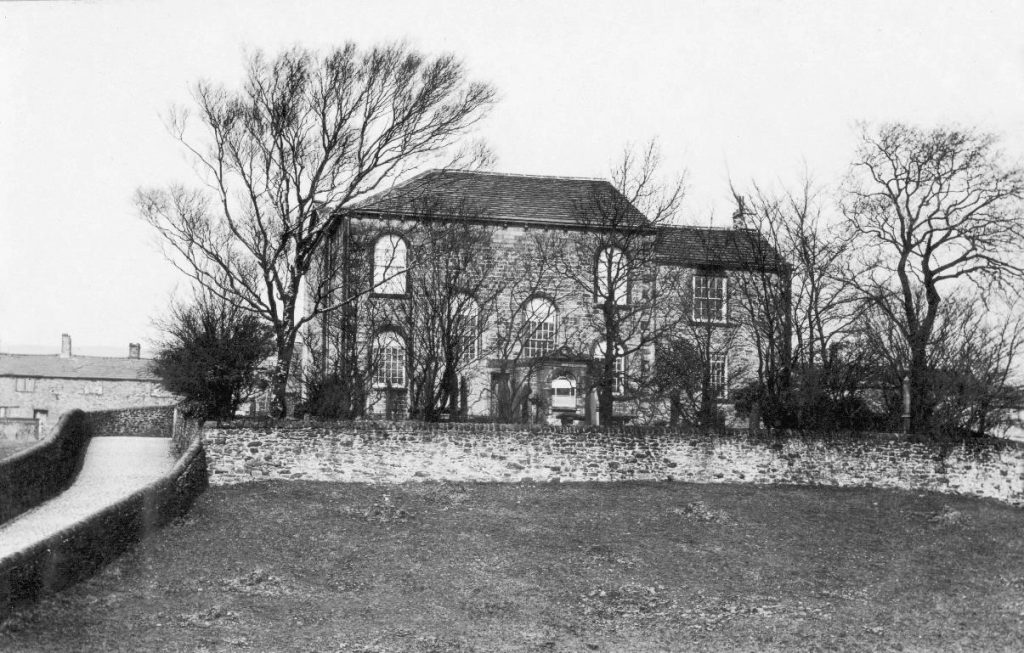
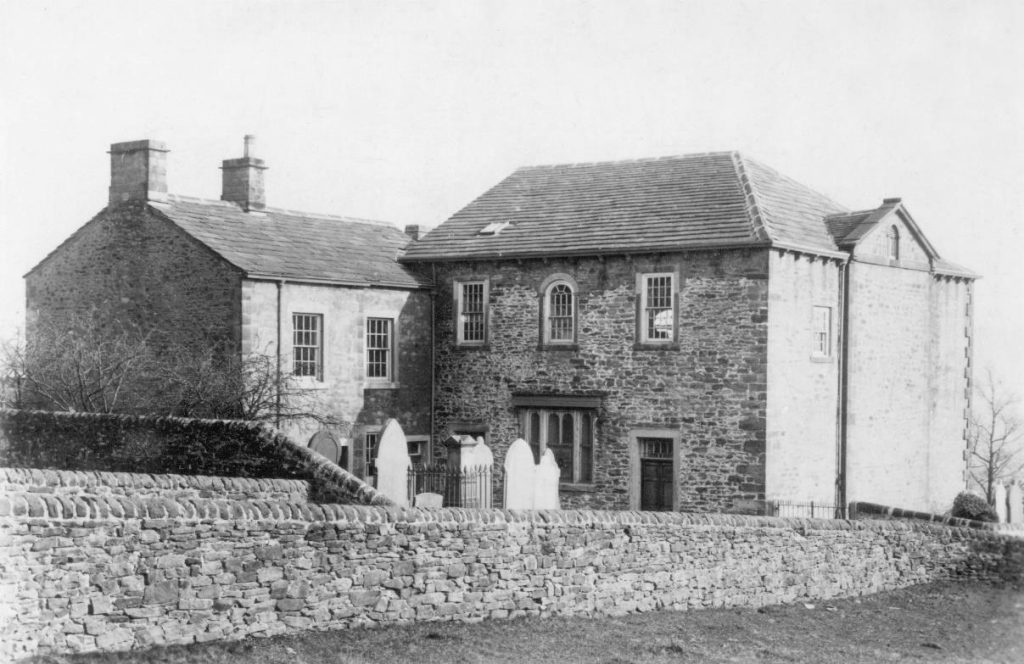
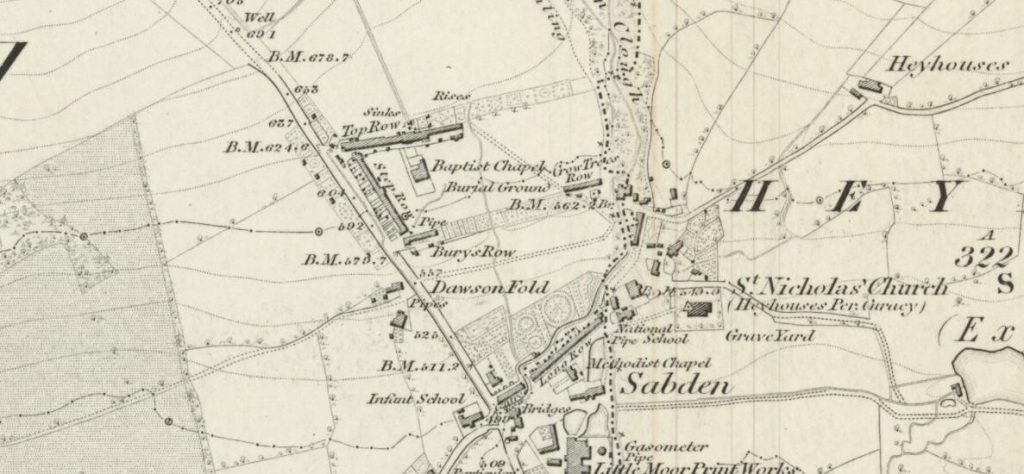
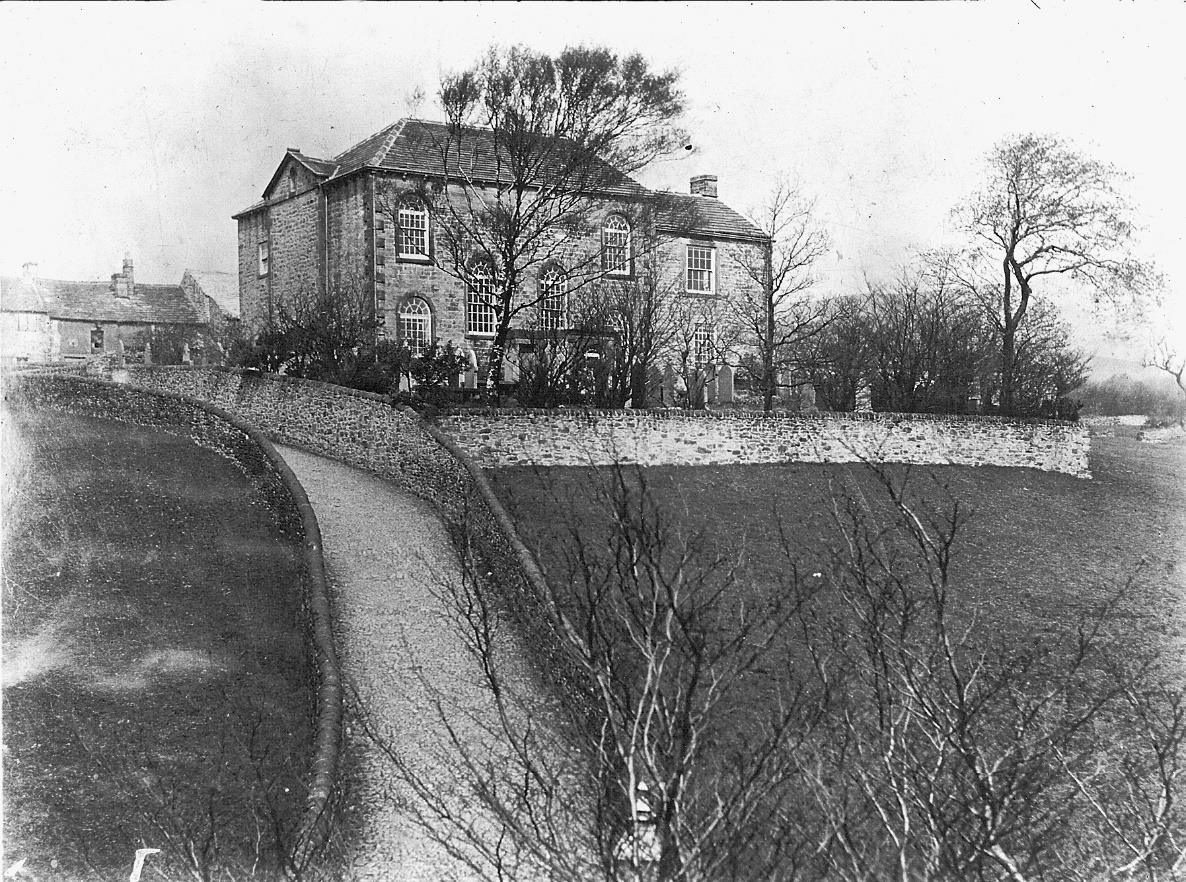
The following letter sheds light on this period (note the address of the sender). It is addressed to the Church at Accrington:
Church at Pendle Hill, May 18th, 1813.
Dear Brethren,
Having for a long time past been destitute of a regular pastor, we have neglected to attend regularly to the Ordinance of the Lord`s Supper and have, as might naturally be expected, grown into a disorderly state in which proper discipline has not been attended to. The bad effects have awfully appeared of the want of watchfulness and that tender concern for our fellow brethren which ever ought to manifest itself by warning the unruly, reproving the disorderly and cautioning the careless. In these circumstances, painful and trying as they are and urged by our distant friend, we have at last come to the unanimous resolution to request your consent that Mr. Edwards may come over here on Lord`s Day in a month or six weeks, at which time we hope to attend to the sacred and solemn ordinance of the Supper. We hope, dear brethren, you will have no objection to this plan, nor to any of your numbers residing here occasionally sitting down with us till such time as the Lord may favour us with a pastor.
In the name, and on behalf of the church.
I am. etc. Christopher Haworth.
The church at Accrington agreed to Mr. Edwards coming once every quarter.
Meanwhile, a John Blakey of Huncoat removed to Sabden in 1815 and did much useful work as a lay preacher, equipping himself for the ministry. He remained till 1824 and was `called` first to Inskip and later to Haslingden.
The third pastor of Sabden Church was Rev. Benjamin Medlock of Olney, Bucks. He came in 1817 and though he had `but slender qualifications for the Ministry`, his efforts were richly rewarded, 25 members being added during his three years of office.
In 1815 the Baptist Association of Lancashire and Yorkshire record no report from the church. This was probably because of the death of James Bury of The Whins who died later that year. The previous year was the first in which the numbers of the church were given in the records of the association, this was 27.
In 1820 came Rev. George Brown of Kingstown, Herefordshire and worked for two years. At this period great commercial depression prevailed. Messrs. Bury failed and the village was thrown into a state of poverty. After a lapse of four years Rev. John Edwards was sent from Greenock by the Home Missionary Society. By a religious census taken thereabouts the number of Baptists in Sabden was 36.
John Edward stayed one year. After his departure the church relied on local preachers, the Accrington ministers occasionally administering the Ordinance.
The work of the Church and Sunday School in those days can well be mirrored in the life of John Bennett, son of James Bennett, a widely known local preacher who came to reside in Sabden in 1835 until he emigrated to America in 1850.
John Bennett, the eighth of a family of twelve (10 sons, 2 daughters), born 1826 was taken to Sabden when six years old to work as a `tierer` at George Foster`s printworks. There were no Factory Acts then and like many others, John Bennett had to work from six in the morning until six and sometimes eight or nine at night, for a wage ranging from 4d to 6d a day. He was not the stuff which gives way under duress but was sturdy enough to rise despite every obstacle. He got what education he could in night schools at the Baptist Chapel and availed himself of a newly organised village library. John Bennett`s life was concentrated in the Baptist cause. He became the oldest member and the oldest deacon. With the desire to express their appreciation of his splendid work the members of the Sunday School class (past and present) on January 22nd, 1902 gave him an illustrated address in album form and a purse of gold containing £40 on his completion of 40 years` service as president and teacher of the Young Men`s Bible Class.
At the time when the Parish Councils Act came into operation Mr. Bennett was elected and appointed first chairman of the Pendleton Parish Council. Educationally he was regarded as one of the leaders in the village and his position in this respect was recognised by the inhabitants when they elected him a member of the School Board on its establishment in 1894. At its first meeting his colleagues appointed him vice-chairman. Mr. Bennett was uncle to the late Mr. W. Carey Hargreaves, JP of Burnley, chairman of the Burnley School Board. John Bennet`s home was for over 30 years never free from sickness and he had business troubles, yet his work for the good of the village never slackened, his courtesy and patience never failed and his Christian heroism gained for him the popular reverence he richly deserved. John Bennett, a man of the too rare type of those whose lives sweeten, elevate and ennoble everything with which they come into contact, died in April, 1904 aged 78.
Thomas Bennett, a brother, after early years in the printworks later entered the Baptist College at Accrington to study for the ministry. At 24 he was pastor of Bethesda Baptist Church, Barnoldswick and succeeded in having a large chapel built. His friends encouraged him to enter the cotton manufacturing business but the American War, with its subsequent disastrous results for Britain, ruined him financially. However, he continued his pastorate until his death in 1886.
The industrial depression of the twenties was largely due to rapidly increasing new inventions in machinery and power. The state of these soon subsided and Sabden, after much bitterness, reorganised its industry. So too in 1833 the church took on a new lease of life. Aided by the generosity of Mr. George Foster, a rising industrialist, the church invited the Rev. John Jones of Bradford College to the pastorate. The latter worked with untiring zeal and marked success materially. In the second year of his ministry the chapel was enlarged by the addition of two schoolrooms erected at the east end of the chapel, at a cost of £400.00. It is interesting to note that amongst those present at the opening ceremony was Mr. Richard Cobden, the great reformer, to whom more than any other the nation was indebted for the repeal of the Corn Laws. He was in the employ of Messrs. Fort Bros. & Co. in 1830 and at the time of the opening ceremony had become MP for the West Riding of Yorkshire. He had contributed largely to the alterations and additions and had canvassed his Manchester friends for the same purpose.
The Rev. John Jones died of consumption aged 29 and was buried in the cemetery on 25th February 1838. He was a mild mannered man and it was considered that his bark was too frail for the stormy sea of life and sunk under the pressure of disease. It was stated of him that he was `an example of the believers in word, in conversation, in spirit, in purity`.
In 1839 The Rev. J. P. Griffiths came and ministered for four and a half years, a period which has been described as the most successful spiritually in the history of the church, 87 persons being received into the fellowship. Prior to 1844 all baptismal ceremonies took place in Churn Clough but in that year a baptistry was constructed within the church. Serious illness obliged Mr. Griffiths to leave his work but he was present at the opening celebrations of Burnley Road Baptist Church, Padiham when the church was handed over by Mr. George Foster as a gift. During these two ministries there was a great influx of people into Sabden, employment now being plentiful at the printworks. It is interesting at this point to see the connection between the industrialists and the church.
During the ministries of the Revs. Jones and Griffiths there was a considerable influx of people into Sabden to take up the plentiful employment. Among these came eight persons of the Strict Baptist type and a cause of that faith was begun. The formation of this church took place at John Lambert`s house in Step Row on Tuesday, 27th November 1835.
The following account is taken from the Church Book, now in possession of Ebenezer Church, Accrington:
`To all whom it may concern, this is to certify that we, whose names immediately follow namely:- John Lambert, John Dobson, Robert Riley, Lawrence Ashworth, John Langworthy, Ellen Dobson and Mary Parsons, now living in the village of Sabden and the neighbourhood …. The precepts, promises and doctrines to be exhibited at all times in harmony with the glorious character of the Inimitable God – instead of the corrupt preaching of this day which mostly embraces the doctrine of Election, i.e. in profession, yet their preaching generally is that of the worst sort of Arminianism – consequently saying and unsaying`.
For about two years they appear to have held their meetings in the houses of friends. They gained many members, among whom were John Thornber and Jonathon Cryer from the General Baptists.
This note appears beside the name of Jonathon Cryer in the Church Membership Book:-
`11th May, 1835, was visited by John Laycock and Jas. Bennett and he stated to them that he had fully made up his mind to withdraw from the Church. May the Lord be with him in the decline of life, his support here and his eternal happiness beyond the grave`.
John Thornber, No. 106 in the Church Book has this note:-
“Withdrawn, gone to church at John Lambert`s, 1st Sept., 1835”.
Desiring better accommodation, some buildings were erected forming two cottages and a shop. A room over the shop and one cottage was set apart as a place of worship. The registration licence for this is dated 3rd day of January, in the first year of Queen Victoria`s reign. The opening day is described in the Strict Baptist Church Book and dated Sept. 17th, 1837. This Church Book ends abruptly in the early part of 1848. This Society of Particular Baptists did not survive for we read:-
`On Monday, 26th July, 1875, to be sold, the chapel or working house of Particular Baptists, together with the dwellings underneath …….etc. Manor of Chatburn, Worston and Pendleton`.
About the time of John Lambert`s Particular Baptist Church, Jonathon Hargreaves began his career as a preacher. His story is most remarkable.
Jonathon Hargreaves was born in Padiham about 1813. His father died leaving four young children to the care of a widow who previously had been in service with Mr. Starkie of Huntroyde and who allowed her to live in a little cot, in what is known as “Nick of Pendle”. Before he was five years old Jonathon was sent as a “tier- boy” to the printworks. The family were so poor they had no clock and Jonathon had to go to a farm a quarter of a mile away every morning to find out the time and then walk barefooted from the `Nick` to Sabden and in petticoats. Young Hargreaves got his first start in life when George Foster of Sabden bought him a suit of clothes and a pair of clogs and he was able to attend Sunday School. By his efforts Hargreaves rose to a responsible position at the Sabden works and later removed to Padiham. There, and at Sabden, Jonathon Hargreaves, who had little education, interested himself in religious work. With a view to assisting the young men of Sabden be conducted evening classes in the school without fee or reward. In 1839 he was elected a deacon and became a local preacher. He was a man of extraordinary energy and determination. He once promised to preach at Waterfoot but finding the roads and railways all snowed-up, he walked over Hambledon Hill. Mr. Hargreaves could not distinguish the fences but walking on walls and hedges he reached Waterfoot, somewhat late, with icicles six inches long on his whiskers and his trousers frozen to his legs. While at Padiham Jonathon Hargreaves used to canvass his neighbours to attend church and if he could not get their consent would kneel in the street and pray for those who would not come. He used moral force at all times and was widely known. By many he was called `The Weeping Preacher` because he not only wept himself but by his fervency caused others to do likewise. Jonathon Hargreaves made great personal sacrifices for the Baptist Cause in NE Lancashire and was finally settled as pastor of Waterfoot receiving 12s. per week for his services. There he caused a new church to be built, since known as `Jonathon Hargreaves Chapel`. It is recorded that during a service in Huncoat Jonathon Hargreaves held his audience until nine o`clock. After the first service, as no-one moved for a few minutes, he stood and remarked that his friends seem disinclined to leave. `However`, said he, `I will give out a hymn and those desirous of leaving the building may do so while the rest remain. I have another sermon here and we will continue the service`. He preached until nine o`clock, none leaving.
Jonathon Hargreaves ministered at Waterfoot 20 years retiring when 57 years old. He died in May, 1879 and was buried in Sabden. As an instance of respect and affection it is reported that the vicar of Waterfoot was present at his funeral service and gave an address while the scholars of the Parish Church School lined the road outside.
In 1846 the Rev. C. Kirtland was minister at Sabden Baptist Church. With a passionate love of freedom he led an attack against Church rates and was also no mean poet. During the pastorate the jubilee of the Church was celebrated with great ceremony and rejoicing.
A description of these celebrations was set out in an article in the Preston Guardian some 35 years after the event:-
`At the Baptist Church meeting held Feb. 2nd 1848 it was agreed to celebrate the jubilee of its formation and arrangements were made and carried out as follows:- On Sunday morning, Feb. 20th, the pastor, the Rev. C. Kirtland preached from Psalms lxxxi, verse 1 – “Sing aloud unto God our strength; make a joyful noise unto God of Jacob” – the very same text as that chosen by the Rev. John Hirst who preached at the establishment of the church. In the afternoon the members celebrated the Holy Communion and on the following day the scholars were treated with tea and buns, afterwards assembling in the Chapel yard where they were joined by a very large company including numerous friends from surrounding towns as well as from a distance. After the singing of a hymn composed for the occasion by the pastor, Mr. Kirtland planted a young oak tree in the lower graveyard. This was called the “Jubilee Tree” and has since grown considerably and a stone tablet inserted in the boundary wall gives its name and the date of its planting. Each of the scholars received an orange in order (as the pastor said) to stamp the event on the minds of the young. In the afternoon the members and friends had tea together in the proper schoolroom when the pastor (not, it seems, Mr. Foster as was stated three weeks ago) read the history of the place compiled by himself and Mr. Foster during the fifty years of its existence. Appropriate addresses were delivered by Mr. Griffiths, a former pastor, Mr. Jonathan Hargreaves, Mr. Geo. Foster, Mr. Geo. Birtwell, Mr. Thomas Bury (Foxhill Bank), and Mr. Richard Harrison (now of Whalley who at the request of Mr. Kirtland spoke on behalf of the Wesleyans), all dwelling upon the pleasant nature of the proceedings and some stimulating the members to renewed exertion, as indeed did the concluding part of the history itself. This stated that the total number of members added since the formation of the church was 253. Of these 141 had either died, moved, been excluded or dismissed to other churches so that the then number was 129, inclusive of the friends who were under the care of the “respected minister at Padiham, the Rev. Mr. Fisher”`.
In 1851 Mr. Kirtland moved to London and was succeeded in 1852 by Rev. J. J. Owen who left in March 1854. For two years the church was without a pastor and the duties were undertaken by the church`s friend and brother Mr Griffiths until 1856 when the Rev. H. Kitching undertook the role until 1858.
Club Day in the village was an annual event much anticipated by local residents. Clifford Moorhouse describes what occurred below:
`Club Day, traditionally the last Saturday in July, was one of the most important dates in Sabden`s calendar. The date was fixed as it was the date when stock taking took place at the calico printworks and the works were stopped. It was formed as a result of the various sick clubs celebrating their anniversaries. It took the form of various organisations processing around the village elaborately adorned with the village band at its head. These included the Foresters, the Gardeners and the Oddfellows, after which they all enjoyed a meal together with visits to the public houses. In the afternoon the members of the congregations and Sunday Schools attached to the church and Baptist and Wesleyan chapels, had similar processions. However, they were independent of each other and each procession took a different route and having arrived at a spot previously agreed upon, formed itself into a circle to sing several hymns which had been well rehearsed for the festival. The ministers and the different employers of labour generally took part in the ceremony, which no doubt tended to cement the good understanding which usually prevailed between the masters and operatives. When the scholars had walked themselves tired and sung, or rather shouted themselves hoarse, they adjourned to their schools and were regaled with substantial tea. After this most of the elder folks withdrew and the younger ones indulged in various games. As twilight drew on almost everyone in the place adjourned to “the bridge” where the two chief inns were situated. On July 30th 1864 a report states that on Club Day a number of young men belonging to the Baptist Sunday School recited the drama “Joseph and his Brethren” in the British School and the place was crowded. To give further proof, the following year, July 29th 1865, was the day when the Baptists on Club Day recited two dramas, one “Belshazzar” and the other “Daniel”`.
In 1858 came the Rev. J. Upton Davis whose work holds historic significance. Mr. Davis first originated the idea of erecting a new chapel more conveniently situated near the new centre of population. Land was secured in Dawson`s meadow behind what is now the Council School but the project was abandoned in consequence of the poverty in the village caused by the cotton famine and few places felt the dire effects more keenly than Sabden. (Many had to resort to the Workhouse in their distress. Others kept body and soul together by long journeys to and from the soup kitchens mercifully organised by Stonyhurst College. Men in their late eighties still living can remember the extreme hunger which existed in the 60`s). The idea mooted by Mr. Davis saw its fulfilment in 1910.
In 1863, Rev. Jos. Patterson succeeded. During his ministry the old chapel was raised four feet in 1865 and other improvements effected at a cost of £687.0. 2½ (Appendix A). Rev. W. R. Skerry of Rawdon College followed. 1873 saw the Rev. J. Norton and 1877 the Rev. D. R. Hamilton who subsequently became a Congregational minister. 1885-88, Rev. J Haslam Jones became Minister but left for the largest church in Gloucester. During this period a Band of Hope was active in the school and their annual picnic was held in August 1886 on Pendle Hill on a very fine day, being much enjoyed by all. 1892-93, Rev. Ernest Mason. The population of the village in 1894 is recorded as being 1300, which is a fall of 700 from 40 years previously.
About this time there was a movement afoot among the younger members of the Church and congregation to organise more social events. The driving force behind this was Jacob Birtwell. His ideas, voiced by the more eloquent J. H. Kenyon, found ready response from the youth but were frowned upon by the more mature. Youth however persisted and at a meeting of Church and Congregation won their point. The ensuing social events and other forms of work began to accumulate funds and the idea of devoting these to the erection of new buildings was once more revived. The scheme caught the imagination of the majority and effort was redoubled.
1896-1905 Rev. A. H. West, B.A., B.D. became pastor. His beneficent ministry is well remembered by many of the older members of the church and on several occasions he has returned to preach and renew old acquaintances. In the first year of Mr. West`s ministry the members of the church received a very liberal offer from the Misses Foster of `The Whins` towards the proposed new Baptist Chapel in the village. This offer consisted of £700 worth of rail stocks for the perpetual rent of a site given by the Foster family and a donation of £1,000 from Miss Sarah. Foster when the members raised an equivalent sum. During the next few years increased efforts were made. £560 was raised at a Bazaar in Oct., 1897.
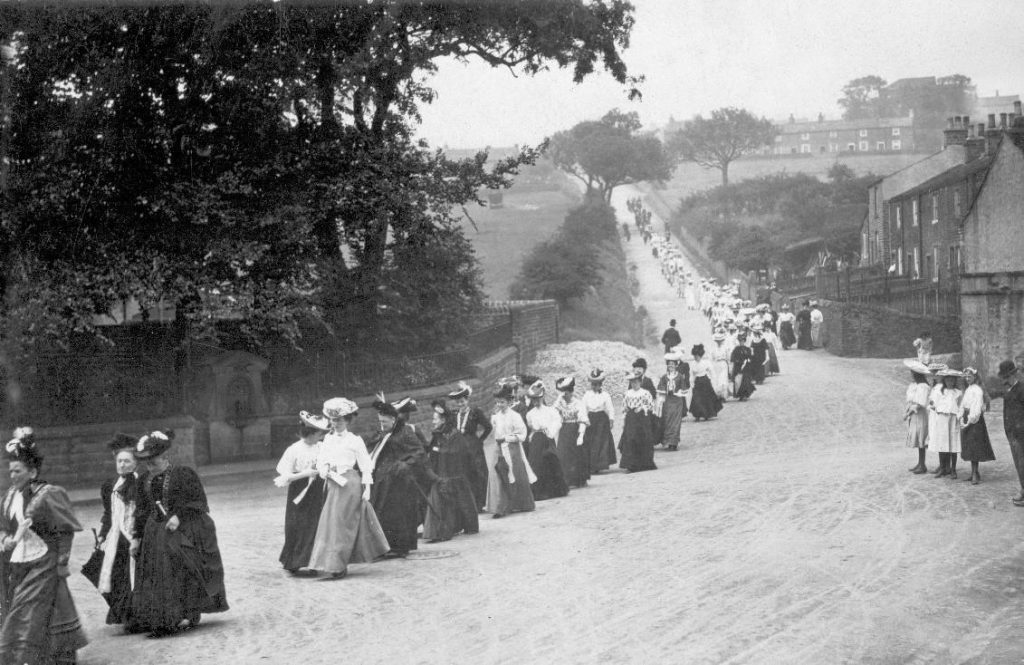
A walking day from the church during the latter part of the 19th century.
In 1898, centenary celebrations took place with Professor George Carey Foster of London officiating. A bronze medallion has been found with the inscription `Sabden Baptist Sunday School Centenary 1898` on the reverse with an image of the chapel and the inscription `Baptist Chapel 1898` on the obverse. Although the church was founded in 1797, the celebrations took place on the centenary of the acceptance by the church of the Church Covenant on the 20th February in 1798. No details have been found relating to any other events which took place, apart from a hymn sheet for the Centenary Services on the 19th and 20th February 1898.
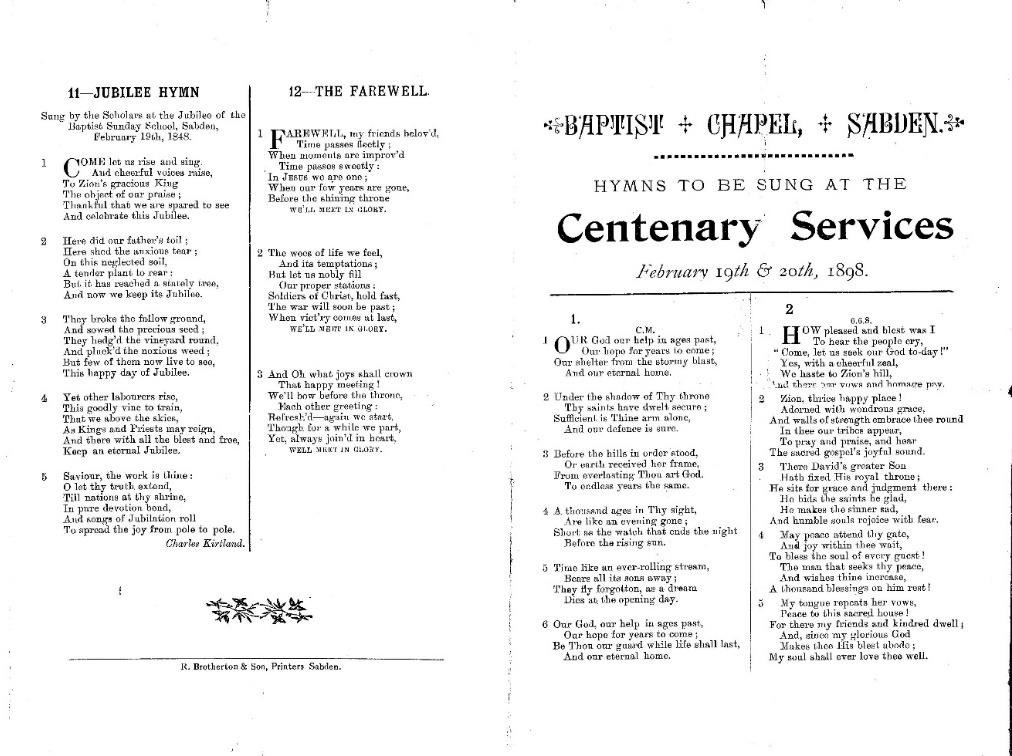
A two day sale in 1899 opened by Mr. William Pratt, headmaster of the Church School, and Mr. H. Bond, a deacon, raised further money for the fund which had by now reached £970. In December 1903 another Bazaar realised £450 to a steadily mounting total – £2,950 being raised towards an estimate of £4,000, but it was not until June 11th, 1910 that the foundation stone of the new church was laid. Many did not like the idea of pulling down the old chapel but they did not let sentiment stand in the way of progress. One factor which no doubt influenced them, was the distance of the church from the centre of the village. Many of the congregation found that the pull up the hill was quite a factor when it came to attending services and events. Mr. West accepted the pastorate of Rawdon Baptist Chapel in 1905 and was succeeded by Rev. J. Gwynne Thomas in 1906.
Mr. Thomas` ministry served for twelve years then accepted a call from Halifax. The transition from the old to the new chapel occupied the first five years of his ministry. At the stone laying of the new Church and School, stones were laid by Mr. G. W. Macalpine, J.P. of Accrington, President of the Baptist Union of Great Britain and Northern Ireland, Mr. T. Griffiths of Manchester, son of a former pastor, Mrs. M. C. Monkton, daughter of a former pastor, Mr. Joseph Wood of Manchester, an old scholar, Mr. Hezikiah Bond, deacon and Mr. W. H. Wood, deacon and president of Sunday School. The buildings were designed by Fred Parkinson, architect, from Blackburn in the Arts and Crafts style. The site was leased from Edmond A. le G Starkie for a term of 999 years from 20th April 1912 at £22.12.O per annum.
The opening ceremony in October 1910 was one well-remembered among present older members. A farewell service was conducted in the old chapel, 113 years old. A procession paraded to the new premises, which were opened by Mr. John Lofthouse. 600 people sat down to tea, among them Mr. A. H. West during whose ministry many efforts were made. The entire cost of the buildings was £6,500 and in 1911 £1,670 was still outstanding on completion of the chapel and school. This was reduced gradually in succeeding years so that in 1920 the debt stood at £400. Then an appeal brought in £560 and removed it completely. It had been a great struggle for the congregation to raise the money for a new church. Great sacrifices had been made and on occasions it was reported that the congregation survived on just bread and jam so that they could donate to the building fund. A scheme was put in place where bricks could be purchased as a means of contributing to the cost.
The minute book of the Building Committee from 1st June 1912 until 17th December 1913 reflects the position at the time. This shows that the church was in some financial difficulty following the completion of the building of the new chapel. At a meeting held on 9th November 1912 the financial position showed that £6831.16s.9d. (approximately £770,000.00 in 2019) had been expended on the new buildings and the deficit was `roundly` £1250.00 (approximately £140,000 in 2019). There was some difficulty in making the repayments due as members of the congregation had given donations and made loans generously. £97 was owed to Mr. Parkinson, the builder, which was disputed. In order to resolve this matter the church agreed to offer £50 in settlement and after much discussion the sum of £65 was accepted in final settlement.
A commercial loan had been obtained of £1000 towards the building costs. After much negotiation in July 1913 an interest-free loan had been obtained from the Baptist Building Fund of £800 (approximately £90,700 in 2019) with repayments of £50 to be made half yearly. This had been accepted and arrangements were then made to repay the commercial loan. When this time came the church found that its accounts were £29.5s.3d short and a loan of £35 had to be taken from the `Womens class` to make the final repayment. The minutes recorded that `the committee was able to rejoice that we are in a position to make arrangements for the repayment of our loan`.
Discussion took place on the methods of raising money to repay the capital and interest on the outstanding loans. A 26,000 one shilling scheme (5p equals one shilling, 20 shillings made one pound) was agreed upon, which would raise £1300. To this end booklets were printed and the scheme went ahead with the idea that participants would collect shillings towards the debt.
The final entry in the minutes dated 17th December 1913 relates to a proposed Reunion of Sunday School Scholars in June 1914. This went ahead as reported in The Times, local newspaper, on the 24th June 1914:-
`Baptist Re-Union at Sabden.
On Saturday a re-union was held in the Baptist Schoolroom at Sabden to which Sunday scholars associated with the old and new schools were cordially invited. It was not surprising to see a large number of old scholars present. The special object in view was a united effort to bring the debt of £1000 now resting on the new premises. In the past the congregation, Sunday School and friends have put forth strenuous efforts to lower the deficit, which was lowered by £250 during the financial year just closed.
The re-union commenced with a birthday tea, for which no charge was made, but it was expected that each one present would place in an envelope a coin for every year of life. Afterwards a public meeting was held in the chapel, presided over by the pastor, the Rev. J. G. Thomas, who gave all a hearty welcome to the place of their younger days. The way in which they had responded to the call spoke well for the old church and Sunday School, which did its work so well. They had come to renew former acquaintances, and to enlarge their souls with joy, but there must be an undercurrent of sadness, for they would have missed many with whom they worked for this old cause. He had no wish to strike a dominant note of sadness; he had hoped that they would have come to a village prosperous but the present crisis in the shape of bad trade had affected the village for a considerable time. Still, that church continued to stand for the best traditions associated with its past. The present members were not a whit behind in sacrificial devotion in their cause and many a town church would give much for its spirit of pious enterprise. The factors were a peaceful deaconate and willing people, and he only hoped that the same spirit that had prevailed in the past might be conspicuously seen in the future. They had received some splendid letters from the Rev. Upton Davies (London), the Rev. R. Major (South Shields), the Rev. A. H. West (Rawdon), and the Rev. A. Jones (Gloucester), former pastors. Mr. H. Bond, (treasurer of the Building Committee), was the next speaker, and he said he was well pleased to see so many old faces. Probably they did not all know what the cost of the new chapel and school was, but it was £6,000. When they commenced to build they expected to open the premises free of debt, but they were disappointed. Since opening they had received, in three years, the sum of £450. And from 1913 to 1914 £191.1s.7d. had been raised by various efforts, and during this time their ordinary collections had not suffered in the least. Miss Foster had set aside £750 at 3 per cent so that the ground rent for 999 years was sure. Fifty people had during that time left them by death or to find work elsewhere. He was, however, again pleased to inform them that the total collection for the tea amounted to over £122. This news was received with cheers.
Mr. W. H. Wood, the senior deacon, spoke.
Mr. John Knowles of Nelson said that on the 27th October of the present year it would be 60 years since he became a scholar at the old school on the hill, and in his younger days he well remembered the great men who carried on the work in the old school and chapel. He must mention the following:- Mr. Foster, and Messrs. J. Foster, J. Taylor, W. Foster, R. Entwistle, Rd. Wilkinson, J. Hopwood and H. Haworth.
Mr. John Brogden (Patricroft, Manchester), also made a short speech: and Mr. Herbert Taylor, Dewsbury, said he believed that the position we held today as a nation was largely due to the influence of the work of the Sunday school and noble teachers.
The musical part of the evening was supplied by the choir under the leadership of Mr. J. Birtwell, and songs by Miss C. Wood and Mr. J. Parsons. The accompanists were Misses C. and E. Wood`.
There is no record as to how often or over what period these Re-unions were held. A programme for the Re-union of the `Young men`s Bible Class` to be held on the 25th January 1902 is extant, part of which is set out below. This displays an extensive programme, during which a presentation was made to Mr John Bennett, who had been teacher of the class continuously since 1860, of an illuminated address and a purse of gold. A public tea was served in the Higher Schoolroom at 4.0 pm for which tickets cost 9d. The proceedings began at 6.30 pm. There is no reference of similar re-unions for the women`s bible class.
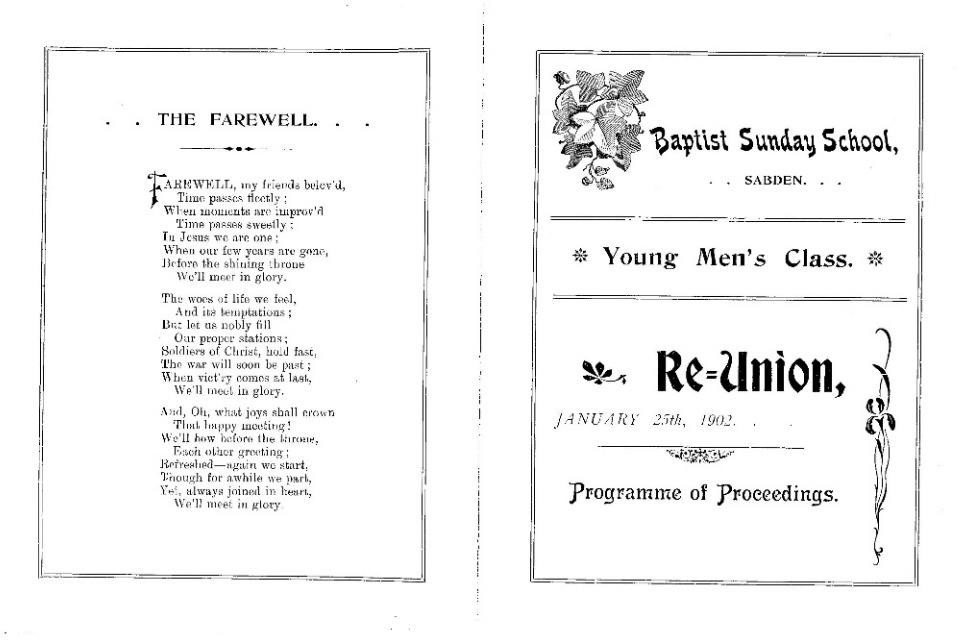
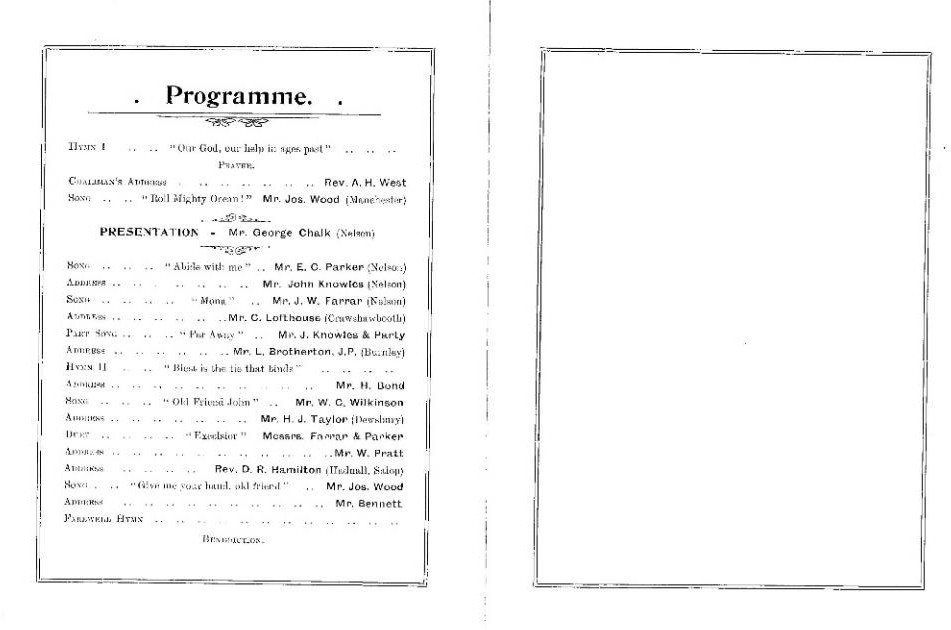
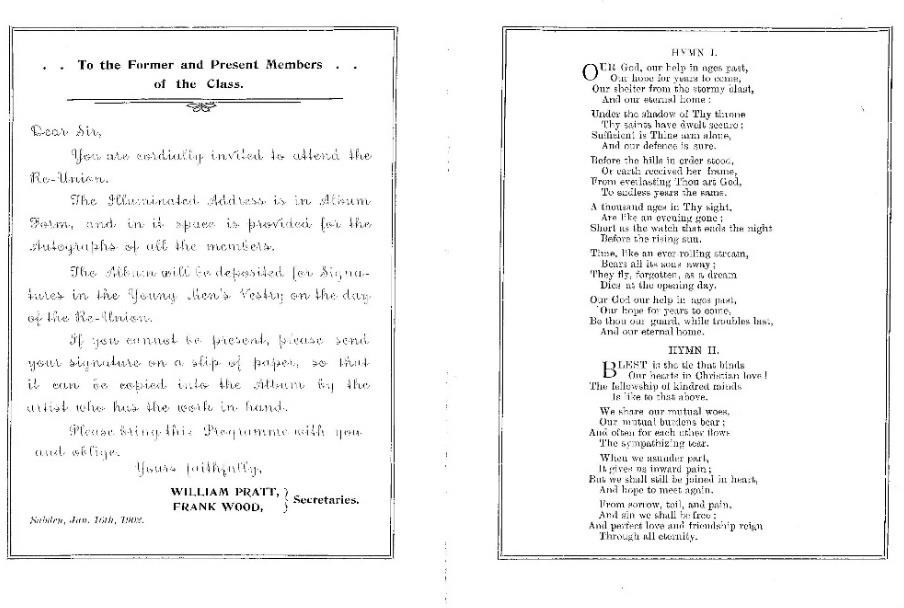
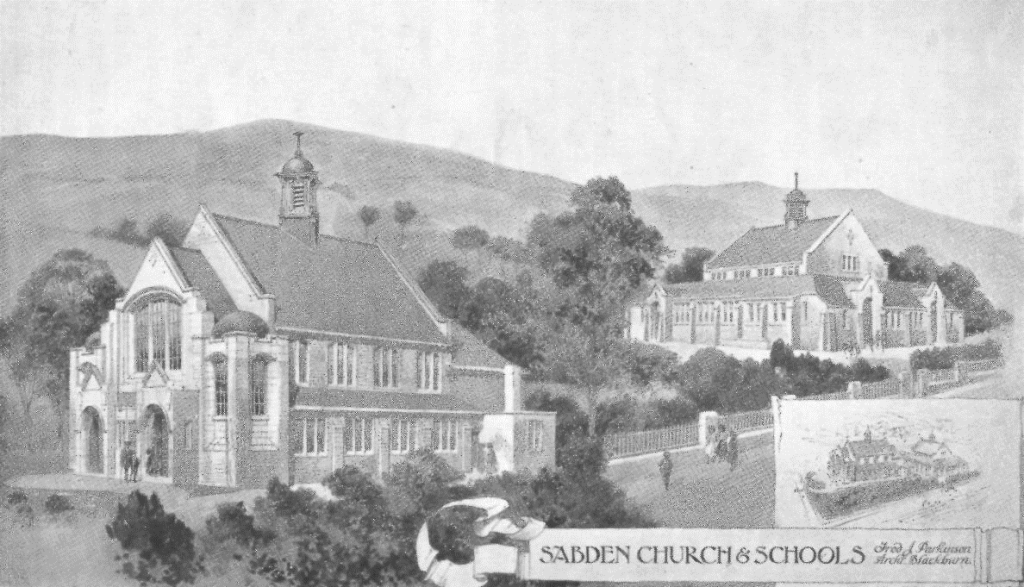
The proposed new church and school
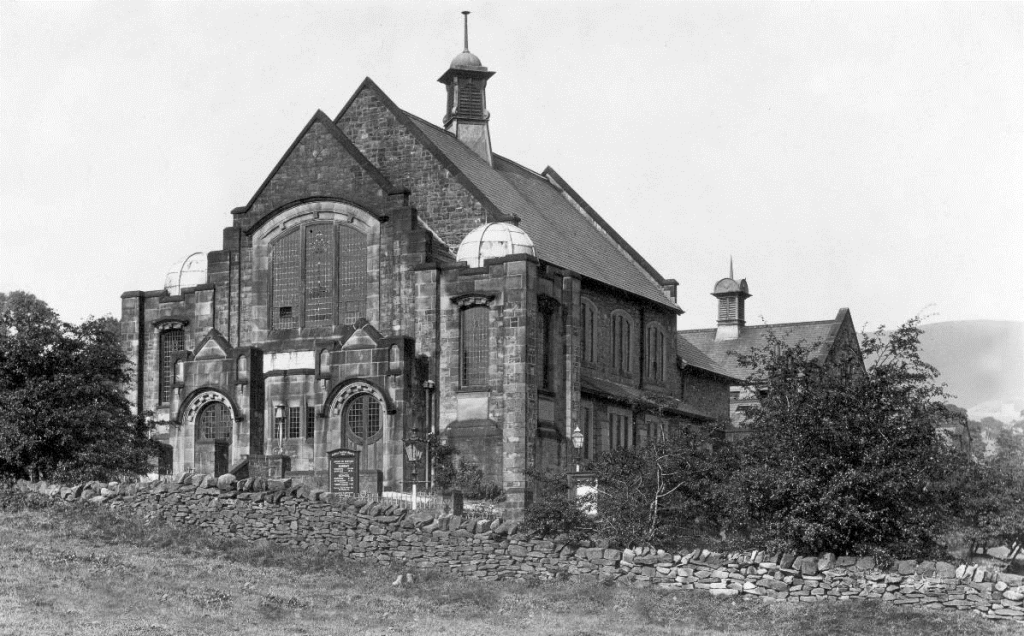
The church from Clitheroe Road
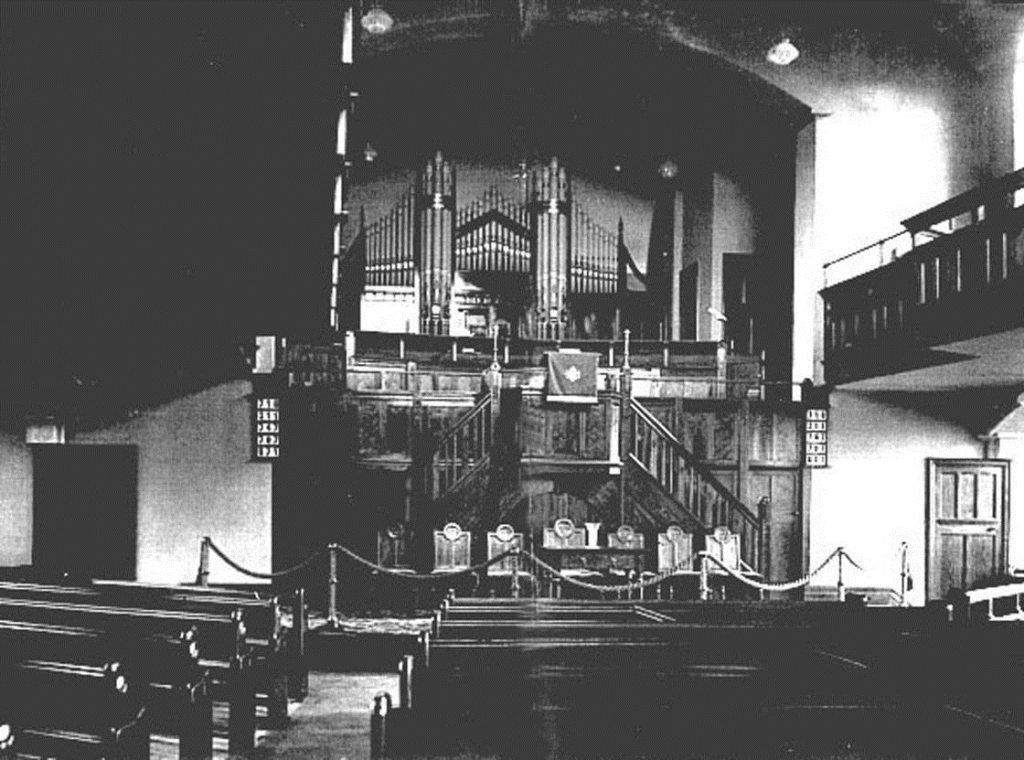
The interior of the church
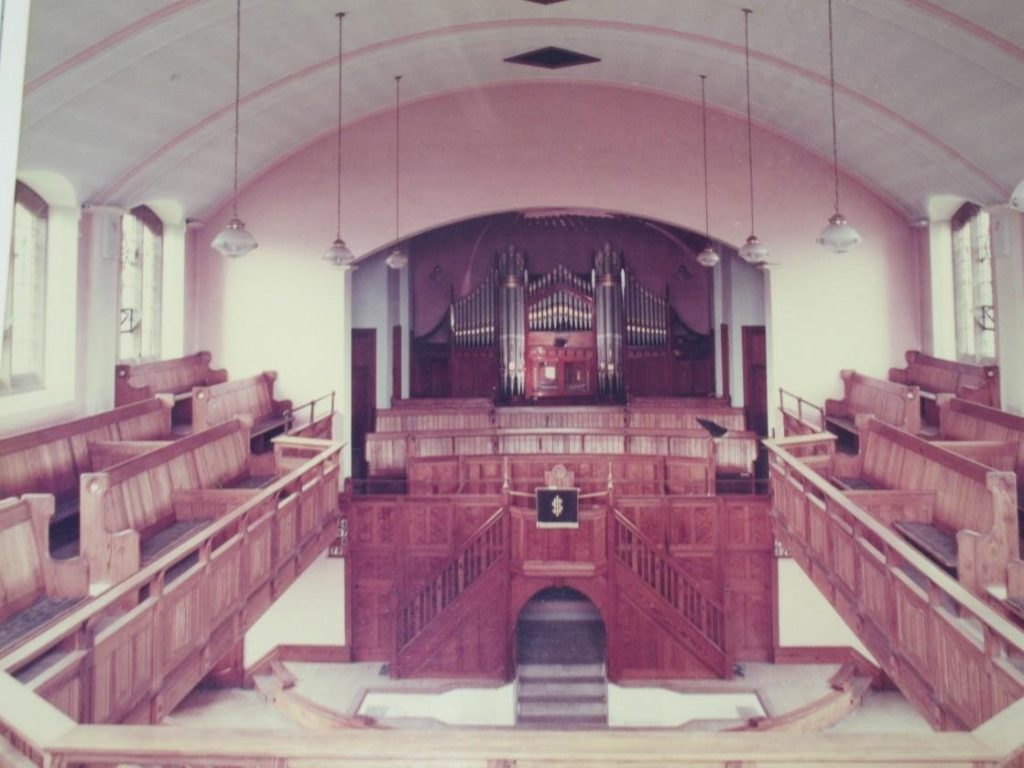
The interior of the church from the gallery
The first marriage in the new chapel was between Mr. Moses Bond and Miss Ann Saletta Green, August 19th, 1911. They were presented with a Bible by the church as a souvenir according to the custom.
Among the laymen so far unmentioned who served the Church up to the years of the Great War if 1914-18 are many names. The first deacon was William Kirk, 1798. Dr John Laycock and Henry Hargreaves in 1917. About John Laycock Mr. Foster said, `For high integrity, simple deep-toned piety, for steady and anxious zeal, in the name of God and especially religious and social duties, he will be long remembered by all who knew him`. Had only `Punctuality and Perseverance` been inscribed on his tomb, everyone would know that tomb to be John Laycocks`.
Other outstanding names of the pre-war generation are Benjamin Laycock, father of the village physician, Dr.John Laycock, the well-known antiquary. He gave sterling service and his loss was keenly felt. Lawrence Brotherton also deserves mention. A faithful teacher for many years he was a staunch adherent of the Temperance Cause being its secretary. John Knowles was an acceptable lay preacher who even when in extreme poverty walked miles to preach the Gospel. He was instrumental in opening up a branch cause at Read. Among the female members who have given conspicuous service we find Miss Sarah A. Foster, second daughter of George Foster. She had a life-long association with the chapel and was a teacher in the school for over half a century. Her kindly and thoughtful acts made her name a household word in the little Pendle village.
The Rev. Benjamin Gawthrop, then pastor of the Baptist Church, Newcastle-on- Tyne, preached a valedictory sermon in Sabden in 1908. Mr. Gawthrop received his first incentives for the ministry while living in Sabden in his youth. He was sent to Rawdon College by Ebenezer Baptist Church, Burnley and came back to say farewell before going to Australia. In 1920-21 he filled the pastorate of Sabden for 15 months while on a health visit. Thus, six sons of the church became ministers:- Jonathon Hargreaves, Thomas Bennett, F. Britcliffe, Ben Gawthrop, George Hitchon and B. Hargreaves.
November 1923. Rev. Matthew Millar, M. A. was invited to become the pastor. An elderly man of simple habits and strict piety, he took up his duties with a fervent evangelical zeal. His personality was such that people felt very conscious of their shortcomings when in his presence. In a post-war world he was a steadying and straitening influence in the ensuring variable reactions to world upheaval.
He was succeeded in 1927 by the Rev. Dewi Levan Morgan, a young minister who immediately appealed to the youth of the Church. He reconciled amicably the ideas and expressions of the post-war age with the somewhat narrower outlook of pre-war generations. By his zeal and infectious enthusiasm he organised the social side of Church and School work and touched a body of people hitherto on the fringe of religious life, undoubtedly influencing their lives to good ends. Even now, after many years, the impact of Mr. Morgan`s ministry in Sabden is felt and his name is spoken by many as that of a trusty friend.
The Rev. D. S. Jamieson, a native of South Shields who had recently completed his training at Manchester Baptist College, came to the church in 1932 and remained until 1938. He was well liked and the church flourished under his pastorate.
Fortunately some copies of The Baptist Monthly have come to light which give some details of the activities of the church during this period:
September 1932
`On Tuesday, July 12th a “Jacob`s Join” was held in our School when “The Jollie Boys” and “Sunshine Follies”, two concert parties connected with the Sunday School made a presentation to Mr. George Hargreaves of two enlarged photographs, one of each group, as their producer and trainer. Miss Elsie Birtwell made one and Mr. Richard Arkwright the other. Mr. Hargreaves suitably responded and thanked Mr. Tom Pilkington who presided. The event closed with a social evening.
Instead of the usual “walking day” the scholars of our Sunday School, along with the teachers and friends, went to Southport for a day`s outing. The party of over 70 went by bus to Padiham Station and here special coaches were waiting to convey them to Southport. The weather was fine and a very happy time was spent. A Baptist School put their premises as the disposal of the party and here buns and tea were served. Our Pastor, Mr. Morgan, accompanied the party.
September 1933
Harvest Thanksgiving. To pour out our gratitude to God for His beneficence in providing for His creatures is the duty of every Christian and it was pleasing therefore to see such good congregations taking part in our Harvest Thanksgiving services on August 27th. In accordance with the custom, the interior of the Church was tastefully decorated with a profusion of plants, flowers and other products of the earth including corn, which gave it a bright and picturesque appearance, and our hearts and voices were raised in adoration and rejoicing to our bountiful Creator for His gracious favour in providing for His people so many good and generous gifts.
The services were in keeping with the spirit of the festival. They were conducted by the Rev. Frank Whittaker of Carlisle who preached appropriate sermons both morning and evening. Harvest hymns were sung heartily by the choir and congregation and two anthems were rendered by the choir namely, “Swiss Morning Hymn” (Franz Abbott) and “Sing to the Lord of Harvest” (J. H. Maunder). Mr. J. Howarth officiated as choirmaster and Mr. H. Whittaker was the organist.
Thanks are due to the many members of the Church and congregation and to other friends for their gifts of flowers, fruit, vegetables etc. for the decorations.
The services were in every way successful and the collections were in aid of the Church funds.
Other Services. On other Sundays during August the Sabden pulpit was occupied by our Pastor who returned to duty on August 6th after holiday.
Mr. Jamieson has also resumed the mid-week services which are held on Tuesday evenings and in connection with these he has commenced a series of addresses on the subject of Christian service which promise to be interesting and helpful.
In the “Baptist Times” of August 17th an article from the pen of our Pastor on Dr. Albert Schweitzer whom he describes as “The New St. Francis” appears.
Jacob`s Join. The ladies of the Jacob`s Join with their president, Mrs. D. S. Jamieson, participated in a very enjoyable outing on August 19th. Numbering 18, they went by special bus to Morecambe where they spent several happy hours by the seaside, returning home at night refreshed and exhilarated in body and mind. They have now under consideration their programme for the coming winter, one of their objects being to raise funds for the redecoration of the Church.
Our Anniversary. Our Church Anniversary Services were held on Sunday, October 31st and were attended by large congregations. The preacher for the day was the Rev. G. C. Thompson, M.A., minister of Sion Baptist Church, Burnley and he delivered two fine discourses. The singing, as usual, was hearty and inspiring and the choir rendered two anthems, “Te Deum Laudamus” (Wm. Jackson) in the morning and “To God on High” (Mendelssohn) in the evening, Mr. J. Foggarty officiating as choirmaster and Mr. H. Whittaker as organist. The collections were in aid of the Church funds.
Week-Night Meetings. These are now being held on Thursday instead of Tuesday evenings so that they may not clash with the lectures and discussions which are being held in the village by the County Education Authority. According to a programme drawn up by the pastor, the first part of the service is purely devotional, following which Mr. Jamieson has arranged to speak on some biographical or other subject or to give a reading or musical performance. On October 21st the subject dealt with was the life and work of St. Francis of Assisi and on the 28th the career of Savonarols, the great Florentine preacher and church reformer of the 15th century was described. Both addresses were most interesting and instructive.
Our Women`s Work. The ladies of the Jacob`s Join have held two meetings during October, both of which were well attended. At the first a reading was given by Mrs. Jamieson, wife of our pastor, and at the second an address was delivered by Mrs. George Hargreaves, a description of beautiful Swaledale. This was illustrated by many fine lantern slides and was very enjoyable and much appreciated`.
The pastorate was vacant until 1940 when it was undertaken by the Rev. W. D. Lewis who ministered until 1944 when he accepted a call to Todmorden. He carried on the work of the church during the difficult days of the war, being particularly active in the welfare of the community which had always been an outstanding feature of the church`s witness. During his ministry a most successful and helpful alliance and joint pastorate was formed with the daughter church at Billington. To his surprise the Rev. Jamieson was invited back to become the joint minister of both churches, which he accepted in 1945 and remained until 1949, when there was a church membership of approximately 108.
At that time the church was very active and special mention is made of former members and adherents who left the village but regularly returned to visit the church, especially those who had been on national service during the war. There was an institute where billiards and badminton was played (the present church building) and the choir which had acquitted itself honourably at the music festivals in Burnley and Blackburn. The ladies of the church met regularly and were actively involved in village affairs.
In 1947 the Ter-Jubilee was celebrated and a publication prepared entitled `No Mean Witness`, which recorded `Sidelights on the History of Sabden and the Baptist Witness there during the last 150 years`. The publication is unattributed but the thanks of the church were given to Mr Richard Wood who researched and wrote the majority of the text.
The Rev Jamieson resigned the pastorate to be succeeded by the Rev. Albert Durrant in 1953. During this period many activities took place at the church. These included a New Year Party, dances and socials, jumble sales and sales of work, outings by coach by the ladies of the church and the Sunday School, to venues such as Blackpool and Morecambe. In June 1960 on Ladies Day Mrs. G. D. Savage (the wife of David Savage, the minister at Sion Baptist Church, Burnley) preached and the ladies choir sang `Consecration` (Jude). In October there was a ladies sale of work, following which, in the evening, the Sabden Baptist Dramatic Society presented a comedy by Peter Blackmore entitled `Down came a Blackbird`. The proceeds amounted to £215. 5s. which was donated to church funds.
The Rev. Durrant retired in 1957 and continued to live in the village. As no pastor had been appointed in 1960 he returned to take the Harvest Service in September. The Rev. Bernard Wilson served the church from 1960-61.
During the period 1962-3 much effort was expended in trying to find a new pastor and several invitations given. In December 1963 the Rev G. W. Rasmussen from Scotland became the minister, a position he held until November 1979 when he died during the term of his pastorate. In April 1967 a joint pastorate was formed between the church at Padiham and Sabden and in April 1970 this was extended to include Mount Olivet. The agreement was that he was to preach at each church every Sunday. During winter months evening services on a Sunday at Sabden were held at the manse at 19 Whalley Road; these services ceased in 1977. At this time there was an active Ladies Group, choir and Sunday School. A village youth club was begun in July 1969 under the leadership of Mr Lowe but ceased in the early 1970s. At the time the Rev. Rasmussen was described as `the finest minister that the church had ever had`; he was fondly remembered and had a close relationship with the village and was ready to get involved in all aspects of the church. He was short in stature and was very happy at Sabden. His widow continued to be active in the church until her death in 1981. Many joint services at this time were held with the Methodist church. The manse was sold in 1979 for £6500 and the house at 131 Whalley Road superseded it; the building being a gift to the church from Miss Boden. The dome over the staircase to the south west corner of the church building was removed in 1972 due to water penetration.
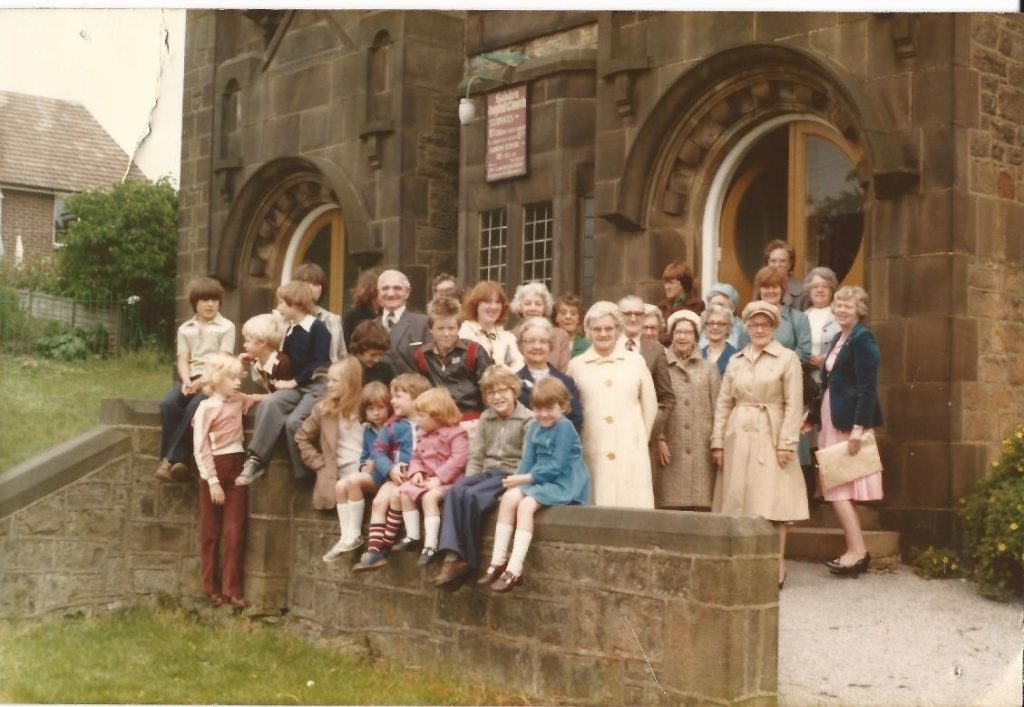
Mr Rasmussen in the grey suite outside the chapel with members of the congregation in the 1970s
The only Sunday School teachers meeting minutes relate to the period 21st August 1966 to 31st November 1971. Fortunately, the annual report for the year 1978, prepared by Miss H. N. Jacques, is available and this is set out below:
1978 has been a successful year for the Sunday School. A new system whereby more members share the teaching was introduced in August, and this gives teachers the opportunity to stay in church for at least two Sundays in a month.
In August the Sunday School trip was enjoyed by both members of the Sunday School and the church. The trip was to Heysham and Morecambe. I think that it is important to keep this part of Sunday School practice as the trips are very worthwhile to increase School numbers.
Prize giving Day on the 5th November was also successful and fortunately extra money raised at a disco and other functions earlier in the year enabled us to spend more money than usual on the books. On the 16th November a jumble sale was held to raise money for the Christmas party; £23 was made which was a great help to boost the now deteriorating Sunday School funds. Early in December a pottery party was arranged by Mrs Trower? and more funds were raised for the Christmas party. Finally the party itself was enjoyed by all and a guitar group was a welcome change for the entertainment.
I would like to thank everyone who has helped to raise funds for the Sunday School during 1978 and those who have helped in any way.
Mr M Taylor. Principal of the Northern Baptist College, Manchester will be preaching at the Anniversary Services on the 15th May 1979.
The Anniversary Service or sermons, held on the second Sunday in November, comprised a service at 10.30 in which the young people played a major role. Details of the service in 1971 record that the service was based on `talents`. The parable of the talents was read and then the children showed what talents they had, e.g. playing various instruments, dancing, singing and skills using their hands. The young people also took up the collection and gave out the hymn books. An afternoon service was held at 2.30 for the adults.
On 27th July 1961 a lease was signed with Lancashire County Council for three years at £90.00 p.a. for part of the school building to be used as the infant class for the village primary school due to lack of accommodation. Some areas of the building were retained for full use by the church, being some side rooms and the billiards room at the north-west corner. The lease was renewed for several years until 1984.
In 1974 proposals were put forward and much discussion was held with the Baptist Union over the formation of a conference centre for the youth in the School Building. In the end no formal agreement was concluded but the building was used on many occasions by visiting groups for this purpose.
The Rev. Don Briddock succeeded to the pastorate in 1978 having formerly been the minister at Mount Pleasant Baptist Church, Burnley. During this period the Sunday School was active, with Mrs Briddock as secretary, with attendance in 1980 being 26 pupils and 6 teachers. Many activities and trips were arranged together with concerts and pantomimes. In 1982 the Sunday School performed `Joseph and the Amazing Technicolour Dreamcoat`. Mr Briddock retired in early 1985 to Hest Bank.
At this time church attendance was low and it was found that the income did not cover the expenditure. The chapel building was also too large for its purpose. The decision was taken in February 1984 to sell the chapel building and use the Sunday School building for services `despite strong emotional attachments to the building`. A small chapel was formed at the north end of the building with an opening made into the entrance passage and some internal walls removed. The chapel building was eventually sold in 1986 for the sum of £15,000 for residential use. A decision was taken to sell the manse following Mr Briddock`s departure.
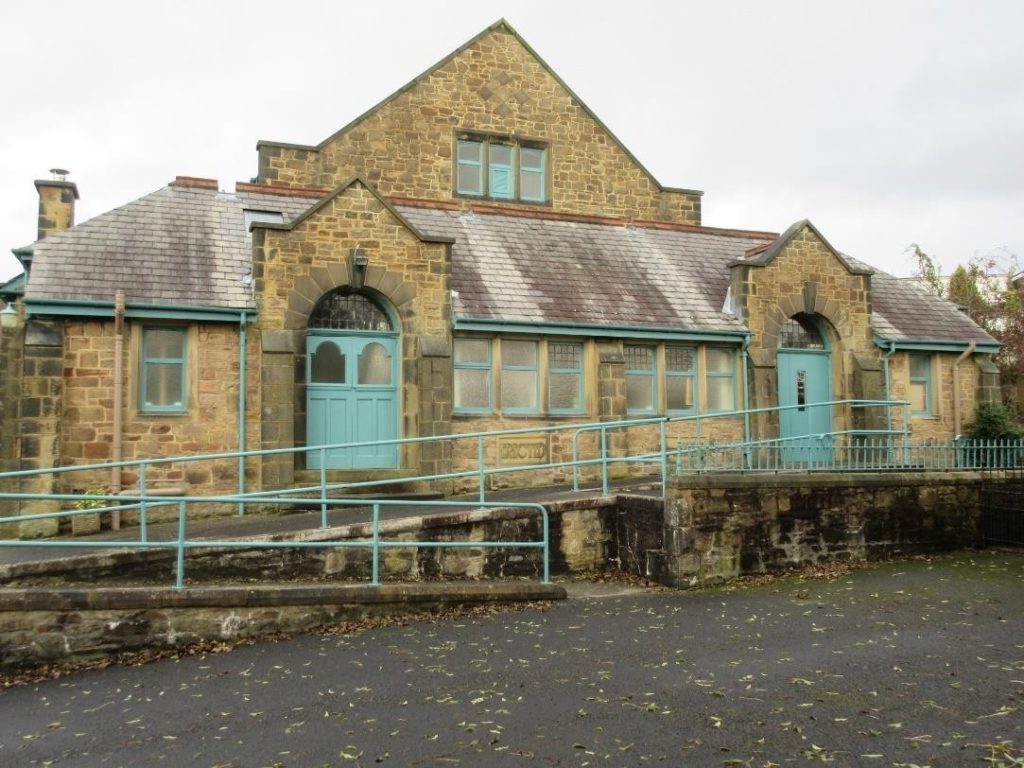
Sabden Baptist Church – the former Sunday School building
In 1985 David Newman was appointed as an APT student minister whilst undergoing training. He was instrumental in reorganising the administration and the various sections of the church. The membership of the church in 1986 was 25. The Spring Sermons are recorded as being traditionally held on the second Sunday in May, and the Church anniversary on the last Sunday in October; in 1986 this was held on 26th October. In March 1986 the village youth club, which was being run as a joint effort with the church, was expanded with a coffee bar and other activities. Many joint services were being held with the Methodist church including evening services at this time. The Rev. Newman retired in May 1997.
In August 1997 the bicentenary of the church was celebrated. An exhibition was prepared showing photographs of past events and former members of the congregation. A china mug was made recording the event and an inscribed manuscript was prepared recording the former incumbent’s for the church which was donated by Russell and Dorothy Dyson (Appendix B). A banner was also made in blue and yellow fabric recording the dates of the anniversary.
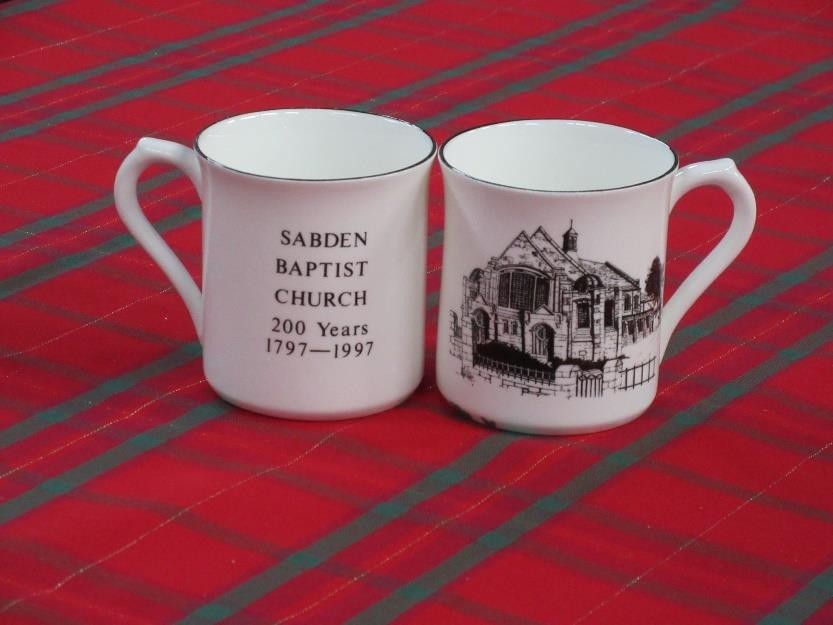
In 2004 an after school club was formed called `School`s Out Club` as part of the church`s commitment to the village.
Tim Peagam became lay minister in 2007. During this period regular activities included a village youth club run on a Friday. This was started by Tim and Joan Peagam and also involved Stephen Hanna of the church. This was popular with attendance regularly around 40 children between the ages of 11 and 18; the club closed in February 2012. The church flourished and gained five new members in 2008. Mid-week prayer meetings were also held together with keep fit classes and a mums and tots gathering. Weekly congregations averaged between 25 and 30 and digitally projected hymns were introduced in 2011. Tim left in October 2012 for a post at the Juniper Tree in Thailand.
Millie (Mildred) Moorhouse, who had a strong personality, was active in the church at the time. Tim Peagam recalls her as follows:-
`Before moving to Sabden we had come across Millie when she used to play for the Whalley Players, a performing arts group, but we got to know her well when we started attending the church in 1995. She was a force to be reckoned with! Always a talented musician, she had begun playing the organ at the church when she was 15, her father was the choir master and she played for practises and for Sunday services. She could turn her hand to any keyboard instrument and lead singing in all its shapes and forms. She would play just as appropriately for a funeral, a worship service or for the whole village at the Service of Light we held at the start of December each year. An extremely talented musician in her own right, for example if Tim said to her `Millie can you play this one (a newer song)` she would reply `I can play that in any key you want.` And could! A real asset to any service leader, she would adapt to impromptu requests, slow things down, speed things up, lift a mood.
Millie was not only the key musician in the church for all those years, she was also a very active member of the congregation. When we started the youth club in about 2004 she would drop in on a Friday evening occasionally to see what was going on, have a brew and chat to anyone there, regardless of age. Our own 3 children were the only young people in the Sunday service for a long time and Millie would always take the time to chat to them each week about things that interested them. She would bring sweets to speak to them and really make them feel valued.
We had several days out as a church and Millie was always on at Tim saying that we should go away for a proper holiday together. Millie always got things done so go away we did. We were a little concerned as she was in her 90`s I think then. However, we needn`t have been. She was up for every activity, ate everything put in front of her and was excellent company, really enhancing the very special fellowship we shared that weekend. We did have to go into a motorway services on the way as she had never been to one. Comment `don’t know what all the fuss is about!
For her 90th birthday we arranged to go and turn her oven off (lunch always left in). We then all went to St. James Church In Clitheroe so she could play the big pipe organ there. It was one of her major, recurring issues, that the Baptist Church no longer had a `proper` pipe organ and she would love to play one again. She took it all in her stride, we all went in, she sat down and played the big organ as if she had not had a 40 year gap ….! We were there over an hour singing some of the great hymns which she played from memory (we had forgotten the music book!).
When Millie was 98 and going strong we decided to apply for an MBE/OBE for services for the community. A very easy application to write but we can`t find it, so sorry! Anyway, about 2 weeks after she died our daughter came in and said, `it`s the Office of the Victorian Order on the phone, what could they want?` They had tried to contact Millie directly but were struggling so they had seen her age and so contacted us. We had to explain she had recently died. She couldn`t tell us which order she was going to be awarded but they wanted to know if she would be able to go down to Buckingham Palace to have it awarded or whether she would need it awarding locally. We laughed and said if a trip to London was in the offing she would have been there like a shot!
Another of the many memories which spring to mind was when we had a phone call from another church member on a Saturday night telling us Millie had fallen down the stairs and landed on the gas heated at the bottom so she wouldn`t be able to be in church the next day. We sorted some music and went to church early the Sunday morning to find Millie there before us, sitting at the organ playing. She had the biggest bandage on her head and a purple bruise spreading from underneath her eye … but she wouldn`t let a small thing like that stop her from making her contribution to the worship`.
Mary Griffiths recalls that there were occasions when a visiting preacher requested certain hymns and Millie would change them as she saw fit and announce, `We are not having that hymn you wanted because we don`t like it and we are having this one instead.` She could never remember a preacher brave enough to argue.
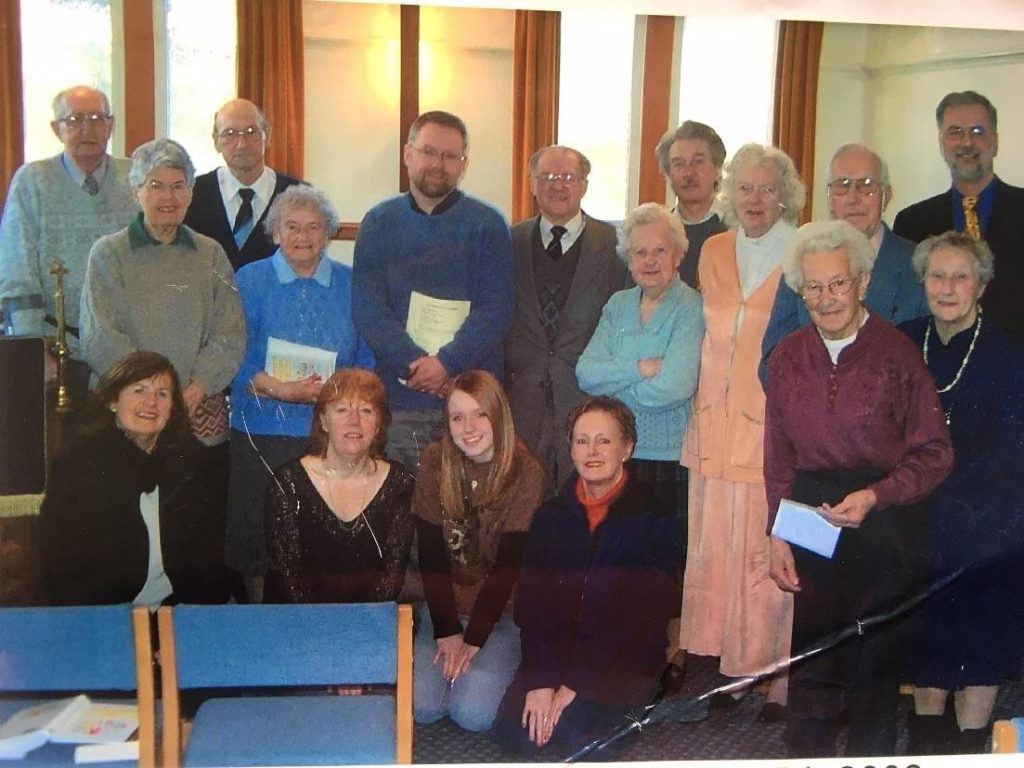
A church group in 2006. Millie is on the end of the second row wearing a necklace. Tim is in the blue jumper with a beard and Joan is in front with red hair.
The Methodist Church closed in 2008 with the final service being held on Sunday 18th May. Prior to the closure overtures had been made to the church to explore a merger but these came to nought. The last service, led by Ian Wheeler, was held in the former school rooms as the former church building had been demolished due to dry rot. As close links had been established with the church many of the congregation came to worship with us.
Patrick Ingle became moderator in January 2013 and served the church for a year. He agreed to preach once a month and make one day a week available for meetings. He would also undertake pastoral visits.
The Rev. Peter Cox followed as a part time pastor in 2013, working also as an undertaker. He commenced his career as a policeman and then was a pastor with the Assemblies of God for 28 years before transferring to Baptist ministry. He was an excellent preacher and membership of the church increased. During his term as pastor 9 people were welcomed into Church Membership. The decision was made to move back into the main hall for services, however, this involved blankets being passed to the congregation so as to keep warm during cold weather. In July 2014 regular attendance at Sunday morning services was 32 with the offerings being around £1400.00 per month. Peter Cox retired in 2016 and was followed in 2017 by Philip Ingram, from the Living Hope Church in Brierfield, as a joint pastor for both churches. However, this arrangement was not successful and he left in December of the same year.
No pastor was subsequently appointed and the services have continued with Mo (Marjoleine Onrust) acting as worship leader and with piano, flute and guitar accompaniment to the hymns. Communion is held on the first Sunday of the month, whilst on the second Sunday an Open Service is held whereby members of the congregation are invited to contribute in any way they feel called. This has been very successful and sometimes there is not sufficient time to allow all to contribute who would like to. On the last Sunday of the month a visiting preacher is invited. Joint services are held with the other churches in the village especially at Christmas where these rotate with the three churches. A Men`s Breakfast is also held with the Sabden churches at regular intervals, which is part of an attempt to encourage the three churches to work together.
During 2018 significant improvements were made to the church building following the receipt of a very generous legacy. The central heating system was replaced, lighting improved, repairs made to the fabric and redecoration undertaken.
The weekly programme in 2019 was made up of the following events. Sunday morning service at 10.30, Tuesday, Caring and Sharing, Wednesday, Bible Study, Thursday, Mums and Tots and Music Practice in the evening.
The present membership of the church is 19 and it is hoped to bring more people into membership shortly. Attendance at Sunday morning services averages 20-25 worshipers whilst attendance at Bible Study meetings on a Wednesday averages around 6 – 8 and the Caring and Sharing Group 10-13 members. This latter group has been founded for over 20 years.
This overview of the history of the church was completed in early 2020 when the coronavirus pandemic was beginning to spread across the world. Along with all other churches in the country the church closed for an indefinite period on Sunday 22nd March, Mother`s Day. At that time the congregation was in good heart and anxious to see its involvement in the life of the village and surrounding areas increase when services and events could begin again. The witness shown by the former members of the church and congregation is an encouragement to us all.
The Church Book
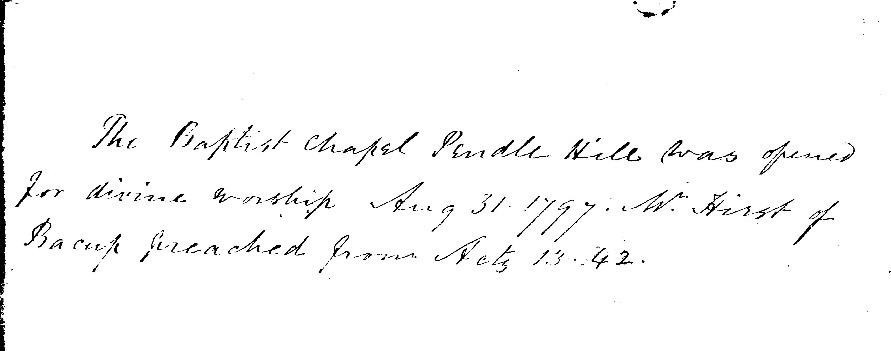
The entry on the second page of the Church Book
When preparations were being made to put the decorations up for Christmas 2019, several boxes of papers which had been stored under the stage were checked prior to disposal. In one box The Church Book was found together with other early records relating to the church. It is considered that these could have been stored under the stage in poor, damp conditions since the bicentenary in 1997.
The Church Book is a mid-brown leather bound volume measuring 9 ¾ “ high x 7½ “ wide x 2” deep (250mm x 190mm x 50mm). On its front face inscribed in worn script lettering is the title `The Church Book 1798`. On the rear is the date 1798 and on the spine the words `C Book`. The purpose of the book is to record the details of church members, which are written on good quality white paper however, many of the leaves are loose. On turning the book over, written on the pages at the back, is a history of the church.
On the inside face of the front cover is written: ‘The Particular Baptist Church Book, Pendle Hill near Clithero (sic), Lancashire 1798 B. Dickinson‘
The title is surrounded by looped decoration.
On the second page is the following inscription: ‘The Baptist Chapel, Pendle Hill was opened for divine worship August 31 1797. W. Hirst of Bacup preached from Acts 13. 42‘
The verses in Acts read `As Paul and Barnabus were leaving the synagogue, the people invited them to speak further about these things on the next Sabbath`.
On the fourth page the following four paragraphs were inscribed in a fine italic hand, each paragraph being divided by a horizontal line:
‘An application to the London Hundees (sic) must be made in September and the yearly letter always went early in that month as well as the collection raised in the church for the promotion of the same fund.
Beryl Dickinson and Wm. Kirk was called to their separate offices by universal sufferage. June 25 1798.
The faith and order of this Church is the same as the Churches (sic) of the Association in Lancashire Yorkshire.
The ministers who were engaged were:
Mr. Littlewood of Rochdale, Mr. Hindle of Manchester, Mr. Hirst of Bacup
The services were solemn and profitable‘
The Church Covenant is then set out over the next six and a half pages and dated 20th February 1798.
A note is added at the foot of the Covenant, presumably at the time it was accepted by the Church, stating that `A very excellent sermon was preached upon the occasion by John Hirst of the Baptist Church at Bacup from Psalm 81.1.` This reads `Sing for joy to God our strength; shout aloud to the God of Jacob!`
Following this the list of members begins with member no.1 being William Kirk who was baptised February 11th 1798. The entries relating to the early members are often accompanied with some of their details. It is interesting that many early members seem to have moved to churches in and around Manchester as is recorded in their transfer of membership. Particular reference is made in the earlier records when new pastors were inducted into membership. The following record relates to a new minister, Benjamin Medlock in 1817, member no. 48:
‘Benjamin Medlock, late a Member of the Baptist Church at Olney in Buckinghamshire was received into full communion by dismission from the above Church, March 24 1817. Settled as pastor over this Church, April 9 1817. Ministry and congregation assembled at 10 in the forenoon. Mr. John Jackson, late a student at Bradford, began the service by reading and prayer. Mr. Pilling of Goodshaw stated the nature of a Gospel Church and asked the usual questions. Dr. Steadman of Bradford prayed the ordination prayer and delivered an excellent Charge from Colossians, 4th chap the middle clauses of the 3rd and 4th verses. Mr. Hargreaves of Ogden preached to the people from Galations, 4th chap, 14th verse, and concluded with prayers. I trust members had to say “that it was a time of refreshing from the presence of the Lord”‘.
Mr. Medlock left the church in 1820 and returned to […….] Bedfordshire.
A further entry relating to Faith Monk member no. 97 reflects the sentiment at the time as set out below:
‘Faith Monk, daughter of James Monkprinter was baptised by Mr Saul Hardacre of Long Preston, on Sunday 9th day of December 1832. This young person was a scholar in the Sunday School Pendle Hill when she was admitted a member of the Church and was the first fruit that has been gathered from that Institution as a scholar altho` several young people had before joined the Church sometime after they had left the School. May this be only as a pledge of a larger harvest from that youthful fruit’.
Faith later transferred her membership to the Church of Christ at Goodshaw on the 2nd September 1835.
The last entry in the membership roll is of Amy M Rasmussen who was baptised at Chadlington Oxford 24th Jan. 1962 and was received by transfer on 14th June 1964. Amy was the daughter of the minister at that time.
The back of the Church Book
The first entry when the book is turned over and opened at the back is:
‘History of the Baptist Church Sabden Lancashire from its formation February 20th 1798 to its 50th Anniversary Feb`y 20 1848. Drawn by Charles Kirkland Pastor and read by him at the Jubilee Tea meeting Feb`y 21 1848.
It has long been an universal custom to commemorate remarkable events at the close of periods more or less remote from each other. The return of the same day of the month on which any remarkable incident transpired brings it more forcibly to our minds, and suggests the propriety of reviving the association connected with it in some suitable form….’
The introduction to this history follows for some considerable length, after which details of the events of the first fifty years are set out. These events have been summarised at the beginning of this record. This history concludes with the following words:
‘Let it be our highest ambition to preserve the Christian name untarnished, and to keep the mantle of our forefathers without a blemish or a rent. The night of sorrow is fast wearing away: the bright and beautiful morning of a perpetual jubilee is at hand, when the ransomed of the Lord shall return and come to Sion with songs and everlasting joy on their heads‘.
The next heading is entitled:
‘A Tea Meeting was held on Christmas Day 1858 of the members only, for which occasion the following Historical Sketch was specially drawn up and read by one of the deacons embracing a period of about ten years say from the Jubilee on February 1848 to the present time 1858.
Out of this meeting arose a most pleasing circumstance which from its importance and value claims to be included in the history of the church and which will be fully explained at the end of this sketch by the letters of the parties concerned’.
The history which was set out covers in detail this ten year period, the essential points of which are already included in this record. Two details which are not included are details of church membership. It is recorded that total membership in February 1848 was 123 whilst in February 1858 it was 219, a very significant increase. It was also stated that in 1851 `a new road was made leading between Bury`s Row and Step Row through Mr. Grimshaw`s meadow, a very great improvement compared with the former road going round by Top Row`.
Following this there is a letter sent from the members of the church to Mr. and Mrs. Foster at Whins House. This was a formal homily in which the appreciation of the church was expressed for their contribution and service for over 40 years. A `silver vine leaf dessert stand` was presented to them as an index of the feelings of the whole church. The letter was dated March 2nd 1859.
A reply of thanks from George Foster and Hannah B. Foster was received and recorded in full but was undated.
The final entry reads:
‘Centenary of the Baptist Church, Sabden. Report read by the minister at the Centenary Meeting 20th Feb. 1898′.
This report was prepared by the minister at the time, the Rev. A. H. West who was pastor between 1896 and 1905. This report is set out in detail and quoted verbatim, as it includes material, which is not recorded elsewhere in this text.
‘We are commemorating today the formation of our Baptist Church here 100 years ago. My duty is only to give a brief account of the condition of the Church from its commencement to the present day.
There is some uncertainty about the beginning of most things, and it has been questioned whether this is really our Centenary year, so just a word must be said first as to evidence; and first we are guided by the Jubilee Celebration which took place in 1848.There are some living and with us today who can remember that, and the Oak Tree in our chapel yard is a memorial. Two very interesting papers read upon that occasion we still have:- one by the Rev. Chas. Kirkland, then the minister here – a history of the Chapel up to 1848. The other even more interesting: an account of the Sunday School during the same period, by the late W. Foster, who was then, Senior Superintendent.
In his paper Mr. Kirkland says, he has documents which show that in 1796 there were between 300 & 400 persons living in Sabden at a distance of between 3 & 4 miles from any dissenting place of worship. In Oct. of that year nine persons met at a house in the valley to consider the propriety of erecting a meeting house and Sunday School. They were James and John Bury, James Sykes, John Entwistle, John Noble. They proposed to erect a building 12 yds. and 8 broad to cost about £400. I may say we have still the old Subscription Book which contains about 120 names and shows that a Committee waited to take such subscriptions in the parlour office of the “Tinker and Budget” (now the “Black Bull”).
Mr. Kirkland continues – “The Chapel was opened on the 31st August 1797. The next thing was the formation of a Church. Accordingly, as a preliminary step the following persons were baptized on a profession of their faith in the meadow adjoining the Chapel on 11th Feb. 1798 Wm. Kirk, Betty Kirk, Thos. Bentley, Ann Bentley and Betty Hirst and on the 20th day of the same month they publicly recognised each other as Christians and solemnly entered into fellowship taking each other by the right hand and subscribing their name to a Confession of faith or Church Covenant.
Mr. Kirkland`s statements are generally confirmed by our Church Book. It contains 1st the Church Covenant, the same I think to which all the Churches of the Lancashire and Yorkshire Association subscribed, with the date Feb. 20 1798 and signed by the Rev. Benj. Dickinson. There is a list of members beginning with the five baptized on the 11th Feb. 1798 and run without a break to the latest members admitted to our Church. Also the Record of Mr. Dickinson`s Recognition Service on the 25th June and of the first Sacrament presided over (the pastor) on the first Sunday of July 1798.
Our Church was formed then on the 20th Feb. 1798 and on that occasion the Rev. J. Hirst of Bacup was present and preached from the 81st Psalm “Sing aloud unto God our Strength”. He must have been a prominent man in those days – An interesting biography of him written James Hargreaves of ….. is in our village library (kindly placed there by Doctor Laycock) throws light upon his connection with Mr. Dickinson – The latter it seems had been a Wesleyan local preacher and so of course an Arminian. He was noted for his fiery tirades against Calvinistic doctrine – the old feud would be fierce in those days – and when he was in Bacup the Baptist minister there was challenged to meet him in Public Discussion. They met and the Arminian was thoroughly discomfited and converted there and then. He became a Baptist and a Baptist minister and Mr. Hirst was present at his Recognition Services in Sabden in 1798.
Mr. D. remained in Sabden till the year 1805 during which time the membership increased from 9 to 33. Since his leaving 17 ministers have held more or less settled pastorates here. There was first an interval of 6 years and then Mr. Jackson of Bradford College came in 1811. He was followed in 1817 by Mr. Benj. Medlock who came from the Church at Olney Bucks. In 1820 the Rev. G. Brown followed and in 1826 Mr. Jas. Edwards of Greenock. Of the labours of these men, we have very little record but in 1833 the membership of the Church stood at 98. In that year Mr. J Jones was elected pastor and remained till his death about 5 years after. It is to his memory the tablets were erected above the pulpit. He received high tribute from Mr. Kirkland and Mr. Foster who speak of his gentleness and piety, devotedness and success. During his stay the Chapel was alongside a new Schoolroom built in 1834 and it is noteworthy that Richard Cobden who in the same year inaugurated the village Library and who was largely instrumental in the opening of the Reform School two years later, is specially mentioned by Mr. Foster as actively and generously assisting and as being present at the opening ceremony.
Mr. Jones was followed in 1839 by a minister to whom our church owes an evangelistic debt – the Rev. J. P. Griffiths. His official ministry of 4 ½ years was, Mr. Kirkland says, “unquestionably the most prosperous in the ministry of the Church”, but he continued to serve the church in many ways and when he left the village in 1859. The Church presented to him an affectionate and eloquent expression of gratitude and esteem.
Mr. Kirkland settled in 1846. He was diligent and aggressive and fought many a good fight in the Church Rates War. In 1852 Mr. Owen was minister remaining only two years. He was followed by Mr. Kitching who remained only the same short period. The next pastor was Mr. Upton Davis and I can testify that his memory is fresh and fragrant in Sabden today. He is our oldest surviving minister and we had hoped that he might be able to be with us today. Unfortunately we have only the substitute of a kind letter of apology – Mr. Davis was followed in 1867 by the late Mr. Paterson, an able and striking preacher whose sermons, some of which are remembered yet. He remained 4 years and in 1868 we feel that we have left the historic past and are dealing with today – for Mr. Skerry is here whom we are delighted to have in our midst tonight.
Then come the names of Mr. Norton, Mr. Hamilton, Mr. Jones and I must add Mr. Mason and last the present minister.
More interesting than a list of ministers would be an account of the men who served and lead the cause as deacons and in this matter we believe our Church has been signally blessed. If I only give a bare list of names many associates will clothe them in many minds tonight – The first deacon was Wm. Kirk – solemnly set apart at the same time as the first minister in 1798. John Laycock and Mr. Hargreaves were appointed in 1817. John Foster, James Bennett, Jonathan Hargreaves and James Barnes were elected in 1839 and Robt. Entwistle and Wm. Foster added in 1848. Mr. George Foster and Mr. Richard Wilkinson were appointed in 1860 and in 1866 Mr. Hy. Wood and John Taylor. Mr. John Hopwood was made a deacon in 1874 and Mr. Hy. Haworth, our Senior surviving deacon was elected in 1880 and shortly after Mr. Chas. Laycock and Mr. J. Knowles, now a member of the Church at Nelson. 1890 Mr. Bennett and Mr. Geo. Hargreaves and in 1896 Mr. John Wood and Mr. W. H. Wood.
The Senior surviving member of our Church is Mrs. Eunice Taylor (widow of John Taylor) who was baptized and received into fellowship hereby the Rev. D. Griffiths of Burnley in June 1836. Next come Mr. Bolton 1839, Mr. Hy. Haworth 1840, Mrs. Mary Wilkinson 1842 and Mrs. Mary Green 1842.
The total number of names in our Church Book is 600. Our present statistics are as follows.
| Members residing in Sabden | 95 |
| Members residing in Billington | 23 |
| Members non-resident | 42 |
| Total | 160 |
Our Sunday School I suspect will hold a celebration of its own in the summer, and I will say little about it here. Since 1819 there have been two schoolrooms and consequently two schools. Boys and Girls. Among the names to be held in special honour in our School Record are those of John Laycock, superintendent from 1813 till his death in 1838, of whom Mr. Foster says “Had only punctuality and perseverance been inscribed on his tomb, everyone would have known that tomb to be John Laycock`s”. John Laycock, Wm. Foster, Benjamin Laycock, John Foster, John Hopwood, Richard Wilkinson – who was not once absent from nor late at his place once in 40 years – and John Taylor succeeding, an able superintendent of equal firmness and kindness. These names among many more. The late Mr. George Foster had a long connection with the school becoming a teacher in 1812 and labouring as teacher and superintendent, besides serving the Church in many other ways up to his death in 1882. To him our Church and School owe a greater debt than to any other man.
I think it carries with it a lesson that all the worthiest names in our Church record figure largely also in the history of our Sunday School. It has had of the Church`s best and it is worthy of it. Of our present teachers five had received the Quiver medal for continuous service extending over twenty years.
The present statistics of the Sunday School are, exclusive of Billington.
| Girls School | Teachers | 16 |
| Scholars | 98 | |
| Boys School | Teachers | 12 |
| Scholars | 89 | |
| Total | 215 |
We have had many branch Sunday Schools, representatives from Billington we have with us today, as far back as 18[..]. Mr. Jonathan Hargreaves was sent down here to start the Sunday School, and at a later date the work was largely helped by Mr. Henry Wood, our brethren Mr. Matthew Slater and Mr. Uriah Cooper have for many years been the leaders of the work and today there is a beautiful little chapel and a flourishing school. A school was for many years carried on at Read, workers crossing the hill every Sunday, and a similar work started at Moor Lane, Padiham in 1840 was the origin of the Baptist Church at Burnley Road, whose respected minister, Mr. Langley, we very gladly welcome amongst us tonight. Prayer meetings were also for years conducted at Red Rock and Wiswell Moors.
And the Church and School have sent their influence further in the men who have gone forth from thence to there to the work of the ministry, Jonathan Hargreaves of Waterfoot, Thomas Bennett, and Francis Bennett, all now deceased, and the Rev. George Hitchon whom we are very glad to see with us today.
There may be room for first a few facts from the history of the building. When erected in 1797 it was a square, plain structure entered from the west and with a vestry on the north. In 1819 two classrooms were built, one over the other and extending the length of the chapel taking in the site of the vestry. School had previously been held in the Chapel bottom. In 1834 the chapel was enlarged by taking in these classrooms and new schools were built on the east side of the chapel.
In 1834 a baptistery was constructed in the chapel; before this date baptisms took place in Churn Clough. About 1850 the new approach to the chapel was made between Bury Row and Step Row. Previously the only entrance had been from the Top Road. In 1861 a Public Meeting was called to consider the question of a new chapel and the scheme was generally approved. A little later a committee was appointed to carry it through. The matter, however, at that time was not pressed forward but the existing building was raised and renovated.
It is not the time to say much of the present new chapel movement, but the need has grown and the opportunity we believe has come again. We do not think it any treason to the past to do, what the faithful workers of those days always did, do our best to take the wisest and every right means for the furthering God`s work here`.
The Christenings and Burials Register and Memorials
The Burial Ground
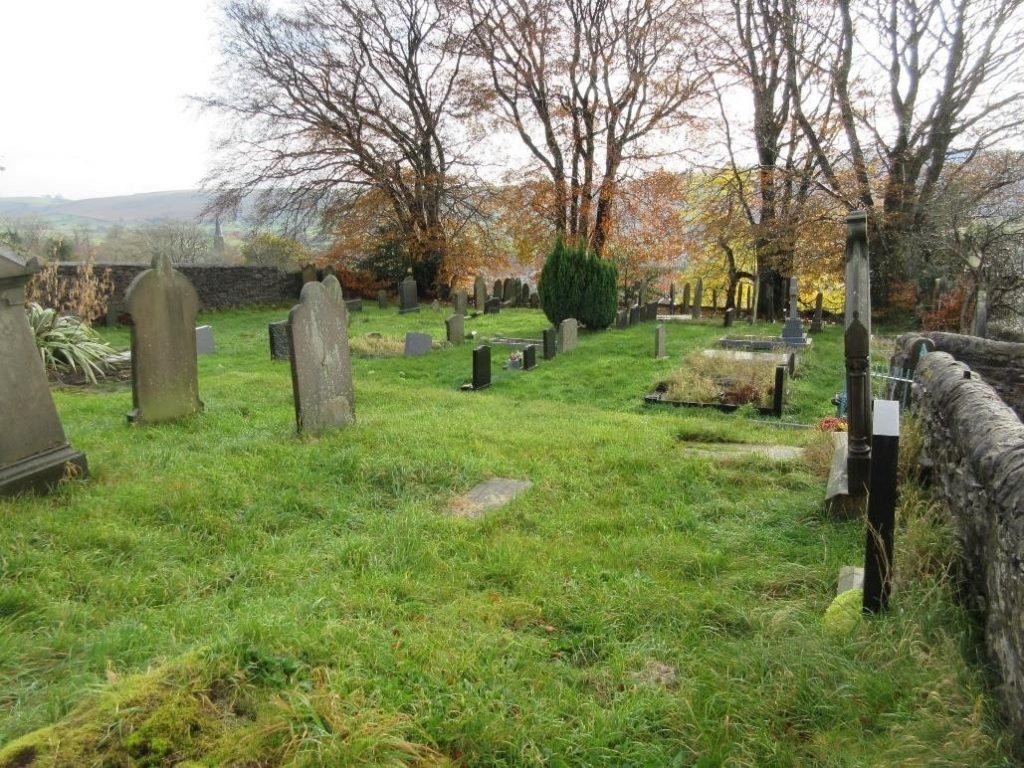
The burial ground, the first church was sited in the middle distance
The earliest record of the christenings and burials of the church are set out in `The Register of the Baptist Chapel, Sabden: christenings and burials, 1787 – 1867`. This unpublished record is available at Clitheroe library.
The first entry of a birth is that of Mary Ann, the daughter of Benjamin and Sarah Dickinson born on the 10th August 1787 at Halifax. This is followed by subsequent ones giving the names of all the Dickinson children. The last entry is that of Mary Adelaid Peel born on the 5th March 1867.
The first burial recorded is that of James the son of William and Betty Kirk in the township of Pendleton in the Parish of Whalley who died the 19th August 1797 and was buried on the 22nd by Mac Adams Dissenting Minister in no. 76 grave. It would seem that the burial ground was in use before the church was opened. The last entry is that of Fanny the wife of Robert Sellers who died on the 2nd November 1819 and was buried on the 5th aged 28 years.
One of the few documents relating to the history of the church is the later Burial Register, which would seem to follow on from the above. This is incomplete and in poor condition with the first few pages missing. The first entry is dated November [ . ] 1837 for the burial of [……] Nuttall, 60 years of age, a labourer `who from being a few years of age worked in the Water Calendar for many years`. The last burial recorded in the Register was on 16th October 1986, although some internments have taken place since but are not recorded, the last one being on the 11th February 2020. The burial ground is now at its full capacity.
Inside the front cover of the Register is a list of ‘Register for the Baptist Burial Ground, Sabden’ and is dated 1861.
It is striking that a major cause of death in the 19th century among adults was consumption and mortality amongst young children was very high. The early entries in the burial register often recorded the cause of death, occupation and in some cases the text used at the funeral service.
Among the church records is a bronze oval memorial plaque which records the sad death of the Elizabeth the daughter of the first minister of the chapel, Rev. Dickinson.
Sacred
To the memory of Elizabeth the third daughter of Benjamin and Sarah Dickinson who departed this life November 28th 1802, aged 18 weeks.
Wife of the trickling tear, suppress the heavy sigh,
To happier climes your baby is borne away.
No sorrows there shall blast her opening bloom,
Nor sin entail the curse of mortal doom.
The seeds of life and bliss to her were given,
To spring from earth and ripen into heaven.
A rose she first adorned her mothers breast
But now transplanted to celestial rest,
Where ever freed from deaths unclement blight,
She drinks the lustre of her fathers light.
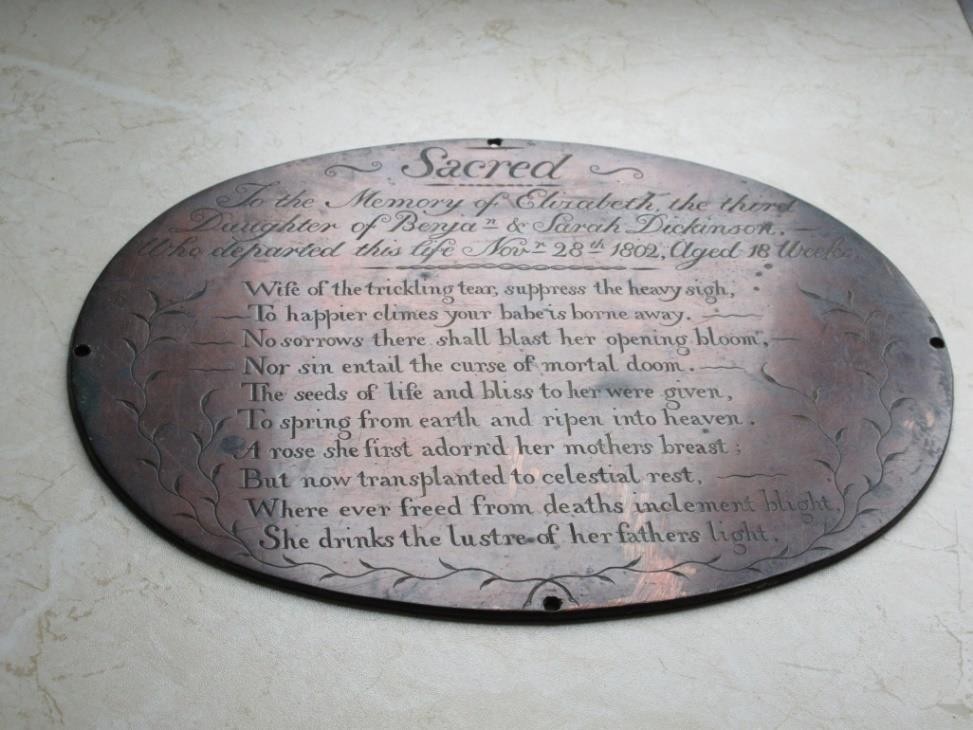
The funeral service was taken by Mr Simmonds of Accrington, described as a dissenting minister, based on the text Romans 8, 28. She was buried in the family vault in the chapel. The Rev Dickinson and Sarah his wife had seven children, three girls and four boys, with Elizabeth being the youngest.
The road leading up to the church between the bottom two properties on Step Row through Mr Grimshaw`s meadow, was only formed around 1850. This provides access only and does not belong to the church. Prior to that access to the building and burial ground was gained via Top Row. In 1976 a cable was laid up the cobbled road leading to Top Row. Unfortunately the area excavated was not re- cobbled but left with a concrete flag finish so as to give a `non-slip ` surface one yard wide. The cobbles remain to either side.
There are three War Graves in the Burial Ground and in 1984 The Commonwealth War Graves Commission agreed to make a payment of £3.00 per grave per annum towards maintenance.
Memorials
It is understood that several memorials were erected in the first chapel, however, their present location is unknown.
These were in memory of: James and John Bury, George F. Foster, Richard Cobden, Rev. John Jones.
The Rev. Jones, minister 1833 – 38, seems to have made a great impression on his congregation in view of this memorial, which was the only one for a former pastor. His large gravestone, still extant, is situated against the east wall of the burial ground.
Two plaques are displayed in the present church building. The earliest is erected to the memory of Miss Sarah A. Foster in recognition of the many years of service devoted to the Sunday School and dated October 1911.
A further undated plaque commemorates the generous gifts for the continuing work of the church made by Lucy and Doris Boden, Ethel Wood and Doris and Hilda Dawson. The plaque recognises the completion of the disabled access and external ramp together with the new toilets in 2004. Their generous legacies made this possible.
Conclusion
In the preceding text an outline of the historical record of the church has been set out. Along with this, many details of events during that period have been included to try and give some indication of the activities, characters and mind-set of those associated with the church. Significant sections of the text of the original 19th century documents have been included verbatim as they portray the wording, phraseology and expressions of the time. These give some flavour of the period so that we can hear people speak over the passage of time.
It is clear that the Sunday School played a major role in promoting the activities of the church and also played a major role in its outreach as can be seen in chapter 3, page 44. It is also reflected in the various re-unions, which we know occurred prior to the First World War. It would seem that these were male orientated as the boys and girls classes were separate in the 19th Century.
The level of commitment to the Church is striking both by the pastors and members. It is also significant that many pastors enjoyed their time in Sabden whilst others clearly found the experience too daunting and left after a short period.
The anniversary of the church as a body on the 20th February is different to that of the opening of the chapel on 31st August 1797. The former was observed up to 1898 however, the latter date was observed for the Jubilee in 1947 and the bicentenary in 1997. The latter date has been chosen by the present church for future celebrations of its anniversary.
The present church and its members have a long legacy to uphold.
Acknowledgements
The help given by David Eaves is gratefully acknowledged together with the photographs of the church and processions. These were given to him by several elderly relatives and friends from the village. I also acknowledge the following who have supplied information or given help, Brian Jeffrey, the staff at Clitheroe library, Burnley Express Printing Co. Ltd., Tim Peagam photograph on p. 34 and many members of the congregation of Sabden Baptist Church.
Bibliography
Barrett, Audrey and Eaves, David, 2004. Sabden Past & Present, A Photographic History, Landy Publishing.
Moorhouse, Clifford, 1975. The Birth of a Lancashire Village, Sabden. Alma Press.
The Register of the Baptist Chapel, Sabden: christenings and burials, 1787-1867. Unpublished.
Unattributed, 1947. “No Mean Witness” Ter-Jubilee Celebrations, 1947. Burnley Express Publishing Co., Ltd.
The Baptist Monthly, August 1932, September 1933, November 1937, Burnley and District Baptist Union.
Appendix A
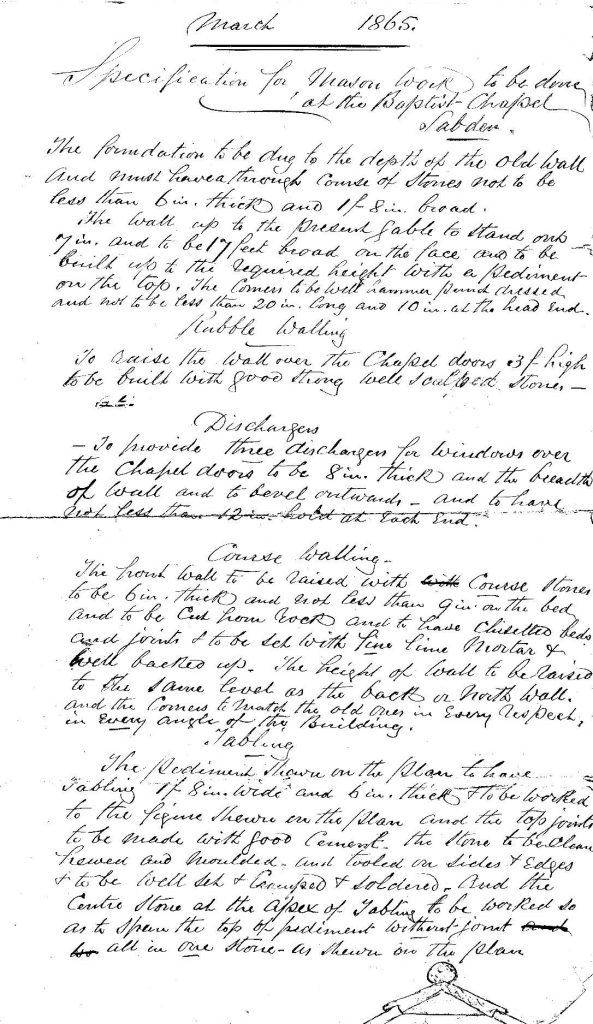
Specification for the alterations to the Chapel in 1865
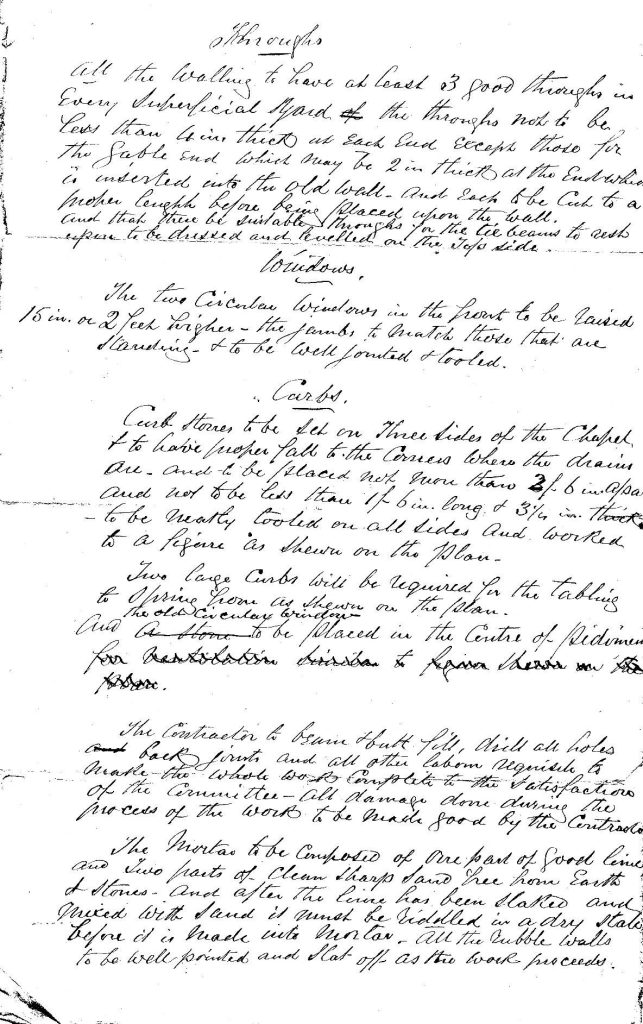
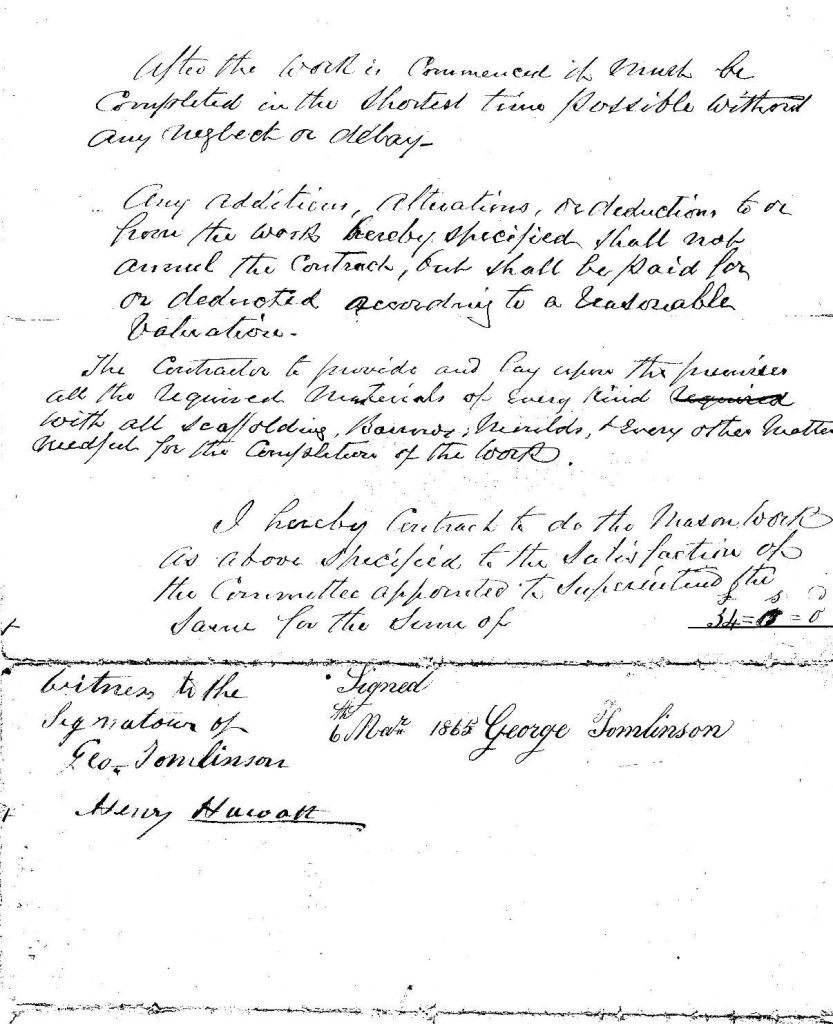
Appendix B
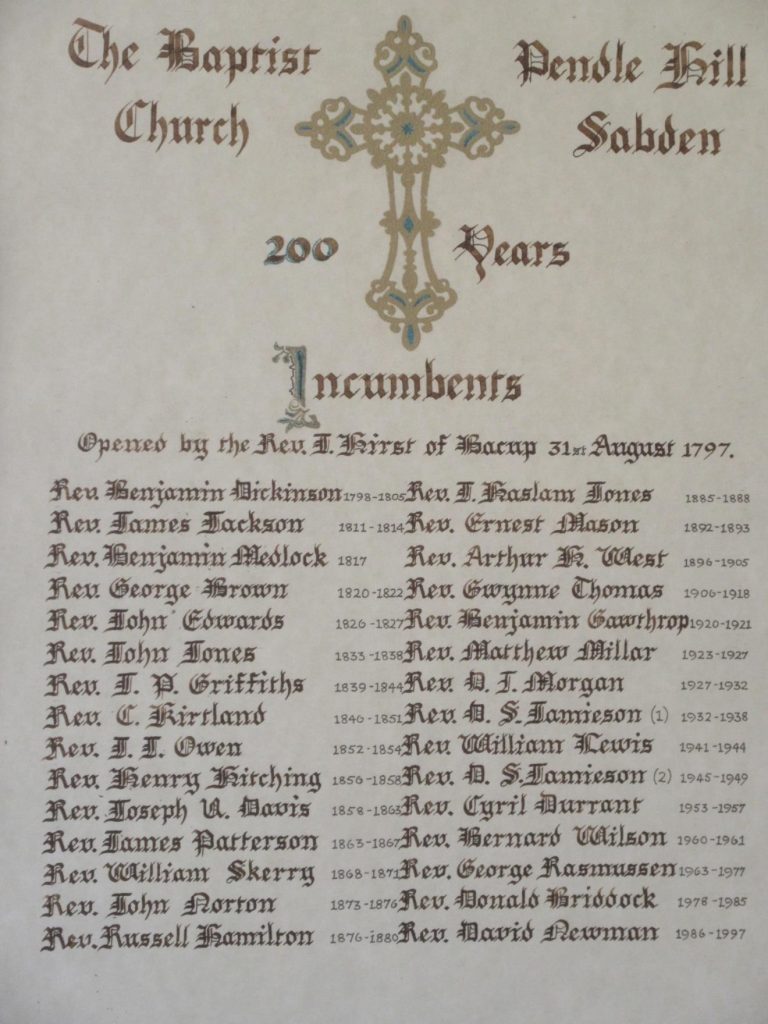
List of Incumbents at the time of the Centenary Celebrations in 1997 from the inscribed manuscript donated to the church on its bicentenary in 1997 by Russell and Dorothy Dyson.